
About UsThe Numismatic Bibliomania Society is a non-profit organization promoting numismatic literature. For more information please see our web site at coinbooks.org SubscriptionsThose wishing to become new E-Sylum subscribers (or wishing to Unsubscribe) can go to the following web page link MembershipThere is a membership application available on the web site Membership Application To join, print the application and return it with your check to the address printed on the application. Membership is only $20 to addresses in the U.S., $25 for First Class mail, and $30 elsewhere. For those without web access, write to: David M. Sundman, Treasurer AsylumFor Asylum mailing address changes and other membership questions, contact David at this email address: dsundman@LittletonCoin.com SubmissionsTo submit items for publication in The E-Sylum, just Reply to this message, or write to the Editor at this address: whomren@gmail.com
BUY THE BOOK BEFORE THE COIN |
- WAYNE'S WORDS: THE E-SYLUM AUGUST 24, 2014
- KOLBE & FANNING SALE #136 SEPTEMBER 12-13, 2014
- NEW BOOK: CASH IN YOUR COINS, 2ND EDITION
- NEW BOOK: EUROPEAN MEDALS IN THE CHAZEN MUSEUM
- NEW BOOK: 2014 CANADIAN NUMISMATIC RESEARCH SOCIETY TRANSACTIONS
- LATIN AMERICAN MEDALS BOOK STILL AVAILABLE
- BOOK REVIEW: CHOPMARKED COINS: A HISTORY
- BOOK REVIEWS: BNR PRESS WWII GUIDES
- DR. ARIE KINDLER 1920-2014
- QUERY: M. DAVID AND HULMEVILLE BANKNOTES
- 2015 INTERNATIONAL NUMISMATIC CONGRESS
- NOTES FROM E-SYLUM READERS: AUGUST 24, 2014
- ANOTHER CHARLES PERCIER COIN CABINET
- QUERY: WHAT IS THIS MORGAN DOLLAR ITEM?
- DC PROGRAM USES WOODEN TOKENS
- COLLECTING WORLD COINS (BUT NOT NCLT)
- GOTHIC ART "COIN" INCORPORATES AGATE INSERT
- HOLABIRD SEPTEMBER 2014 WESTERN AMERICANA SALE
- GALE PUBLISHING FOUNDER FREDERICK RUFFNER DIES
- WHO GETS YOUR E-BOOKS WHEN YOU DIE?
- QUIZ ANSWER: FIELDS MEDAL DESIGNER R. TAIT MCKENZIE
- PHILADELPHIA MINT HITS NEW COIN PRODUCTION RECORD
- THE ASSAYER'S BLOWPIPE
- CLASSICAL NUMISMATIC GROUP AUCTION 97 HIGHLIGHTS
- RESEARCHERS UPDATING BETTS ON AMERICAN COLONIAL MEDALS
- THE FOLEY COLLECTION OF EARLY ENGLISH MEDALS
- HOWARD BERLIN VISITS THE NEW ORLEANS MINT
- NORSE-AMERICAN COPPER DIE TRIAL DISCOVERED
- 1909 VDB LINCOLN CENT STILL GATHERING DUST ON MARS
- RUSSIA REFUSES TO TOUCH APOLLO'S GENITALS
- AUSTRALIAN GROUP TOSSES FOUND CHINESE COIN BACK IN SAND
- JERSEY GROUVILLE HOARD BEING DISMANTLED
- RAMTHA GOLD WISDOM COIN
- THE DO-IT-YOURSELF BOOK HEADBOARD
- FEATURED WEB SITE: NUMISMATIC NETWORK CANADA
Click here to access the complete archive
To comment or submit articles, reply to whomren@gmail.com
WAYNE'S WORDS: THE E-SYLUM AUGUST 24, 2014

New subscribers this week include: Michael Shutterly and Chris McDowell. Welcome aboard! We now have 1,760 subscribers.
Guess what? It's my birthday. Thanks, Mom! Thanks also to several readers who passed along their birthday wishes, including Bill Eckberg, Mike Marotta, Bob Evans, John Kraljevich , Paul Withers, Oded Paz, Scott Barman and others. By the way, it's also the birthday of E-Sylum contributor W. David Perkins. Happy Birthday!
This week we open with an auction preview from Kolbe & Fanning, three new and recent books, and a review of Colin Gullberg's new work on chopmarked coins.
Other topics include Dr. Arie Kindler, the 2015 International Numismatic Congress, silver ingots, circulating world coins, R. Tait Mckenzie, early English medals, and the New Orleans Mint.
To learn more about the assayer's blowpipe, scorification dishes, the Baltimore gold hoard, numismatist William Bowman, the Kadman Numismatic Pavilion, and Charles Percier's coin cabinets, read on. Have a great week, everyone!
Wayne Homren
Editor, The E-Sylum
KOLBE & FANNING SALE #136 SEPTEMBER 12-13, 2014
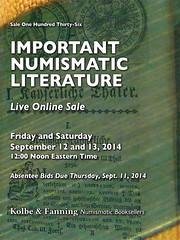 Kolbe & Fanning Numismatic Booksellers Auction September 12-13
Kolbe & Fanning Numismatic Booksellers Auction September 12-13
Kolbe & Fanning Numismatic Booksellers have announced their latest auction sale of numismatic books, periodicals and catalogues, to be held September 12-13, 2014. The sale will feature live online bidding and will be held as an internet auction, though bidders may place bids by other methods if they prefer.
The two-day sale features important material on European numismatics from the library of a longtime dealer.
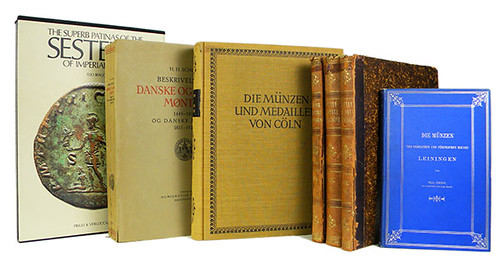
Highlights include:
Classic works on German numismatics by Alexander von Hessen, Joseph Appel, Emil Bahrfeldt, Max Bernhart, Heinrich Buck, Karl Wilhelm Dassdorf, Karl Domanig, Ernst Fischer, Karl Friedrich, Paul Joseph, Viktor Katz, Wilhelm Freiherrn Löffelholz von Kolberg, David Samuel Madai, Alfred Noss, Carl Freiherrn von Schrötter, Karl Gustav Ritter von Schultthess-Rechberg and many others.
Important European auction sales including the 1897 Unger sale, the 1888-1909 Sammlung Engelhardt, the 1943-45 Grantley sales, the 1902-03 Rainer collection, the 1904 Chelminski sale, the 1932-34 sales from the Fürstlich Fürstenbergischen Münzkabinettes Donaueschingen, Sammlung Eugen Felix (1895), the 1909-11 Stroehlin sales, the Collection Legras (1882-83), the Ludwig Belli sale (1904-05), the Count Ferrari German sales (1926-29) and many others.
Other European classics including Bernays and Vannérus on Luxembourg, Demole on Geneva, Galster on Danish and Norwegian medals, Habich on Italian Renaissance medals, Hildebrand on Swedish commemorative medals, Hutten-Czapski’s important work on Polish coins, Netscher and van der Chijs on the coins of the Dutch East Indies, Schou on Danish and Norwegian coins, and much else.
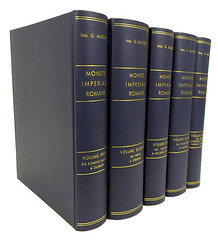
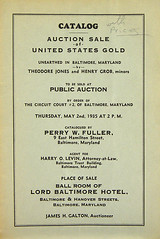
Books on ancient coins will also be offered in the sale, as will material on U.S. numismatics. Some highlights from these sections include:
- Biaggi’s work on sestertii
- Cahn on Naxos
- The text volume of Haeberlin’s Aes Grave, from the library of Edward T. Newell
- A set of Mazzini’s important work on Roman imperial coins
- Both Schlessinger sales of ancient coins from the Hermitage
- The dedication copy of David Cassel’s important work on postal currency, as well as regular copies of the first and second editions
- The scarce Perry Fuller auction sale of the Baltimore gold hoard, with the very rare prices realized list
- Scarce U.S. banking histories including Emory Wendell’s two-volume work on Michigan.
Through live internet bidding, bidders will be able to participate in the sale online as they would in a live auction, using the custom bidding platform developed for Kolbe & Fanning by the popular online auction service iCollector.com. To see the new Kolbe & Fanning live online bidding site, please go to auction.numislit.com. Bidders preferring to bid by mail, fax, phone or email may continue to do so, but all such absentee bids must be received by September 11. Absentee bids cannot be accepted on the sale dates.
Kolbe & Fanning’s website is www.numislit.com and their live online site can be reached at auction.numislit.com. We look forward to your participation.
NEW BOOK: CASH IN YOUR COINS, 2ND EDITION
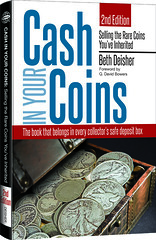 Whitman Publishing announces the release of the expanded, updated
second edition of Cash In Your Coins: Selling the Rare Coins You’ve Inherited, by Beth Deisher. The 304-page book will be available online (including at Whitman.com) and from book sellers and hobby shops nationwide on September 13, 2014, for $9.95.
Whitman Publishing announces the release of the expanded, updated
second edition of Cash In Your Coins: Selling the Rare Coins You’ve Inherited, by Beth Deisher. The 304-page book will be available online (including at Whitman.com) and from book sellers and hobby shops nationwide on September 13, 2014, for $9.95.
The first edition, published in June 2013, won the Numismatic Literary Guild’s “Best Specialized Book on Numismatic Investments” award for 2014, and a first-place nonfiction award from Ohio Professional Writers. The second edition is expanded with 16 additional pages, updated case studies, a new chapter on taxes, new illustrations, and more.
Deisher wrote Cash In Your Coins to inform and protect the hundreds of thousands of Americans who already collect coins, and those who will someday inherit their collections.
Coin collecting is a popular national pastime, and Deisher says, “It seems almost every American family has a stash of ‘old coins’ passed down through the years.” The hobby’s popularity is not new: Whitman Publishing has sold more than 23 million copies of its annual Guide Book of United States Coins (the “Red Book”) since 1946.
Valuable coins might be archived in safe-deposit boxes; they could be tucked away in Grandpa’s cigar box. They might compose a carefully arranged collection—or sit jumbled in a disorganized hoard. Cash In Your Coins answers questions that inheritors often ask: “How rare are these coins? What are they worth? Should we sell? Where would we even begin?”
Author Beth Deisher is an award-winning journalist and retired editor of Coin World, the premier news weekly for collectors. For more than 30 years she has answered the questions above. In Cash In Your Coins, she guides readers through the process of making sense of their coins, and making smart decisions when they sell.
Q. David Bowers (research editor of the Red Book) says, “With Beth Deisher’s guidance you’ll avoid costly mistakes and make decisions about your coins with more confidence.”
In addition to giving confidence to tomorrow’s inheritors, Cash In Your Coins gives comfort to today’s collectors. They can keep a copy of the book alongside their collection, knowing it will be there to give their heirs profitable knowledge and advice.
Cash In Your Coins, 2nd edition • ISBN 0794842383
Softcover • 6 x 9 inches • Full color • 304 pages • Retail $9.95
For more information, or to order, see: Cash in Your Coins 2nd Edition, Selling the Rare Coins You've Inherited (/www.whitman.com/store/Inventory/Detail/Cash-in-Your-Coins-2nd-Edition-Selling-the-Rare-Coins-Youve-Inherited+0794842380)
NEW BOOK: EUROPEAN MEDALS IN THE CHAZEN MUSEUM
 European Medals in the Chazen Museum of Art
European Medals in the Chazen Museum of Art
Highlights from the Vernon Hall Collection and Later Acquisitions
Introductory Essay by Stephen K. Scher
Contributors: Philip Attwood, Arne R. Flaten, Mark Jones, Douglas Lewis, Eleonora Luciano, Joseph G. Reinis, Stephen K. Scher, Jeffrey Chipps Smith, Louis A. Waldman
Edited by Maria F.P. Saffiotti Dale
Softcover, illus.
ISBN: 978-1-93327-017-3
List price: $39.95 (plus S&H)
Member price: $27.97 (plus S&H)
Chazen Museum of Art, University of Wisconsin-Madison
American Numismatic Society
2014
This grouping of medals represents the museum’s Renaissance, Baroque, and nineteenth-century highlights and illustrates the history of the art of the commemorative medal. This catalogue incorporates the scholarship of nine international medallic experts. Their erudition, consummate research skills, and effective prose are evident in sixty-one essays on some of the masterpieces of this art form written for the education and enjoyment of students, specialists, and the general public alike.
expected ship date: October 2014
For more information, or to order, see: European Medals in the Chazen Museum of Art (numismatics.org/Store/ChazenEuroMedals)
NEW BOOK: 2014 CANADIAN NUMISMATIC RESEARCH SOCIETY TRANSACTIONS
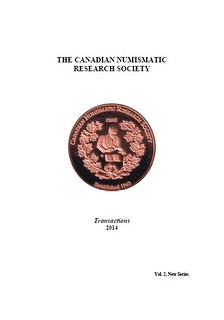 I'd like to make the readers of The E-Sylum aware of the Canadian Numismatic Research Society issue of the (New Series) Transactions Volume 2 for 2014.
I'd like to make the readers of The E-Sylum aware of the Canadian Numismatic Research Society issue of the (New Series) Transactions Volume 2 for 2014.
The contents include:
- Scott Douglas, Biographical Notes
- Len Buth, London Ontario’s Earliest Numismatist William Bowman
- Ron Cheek, Re-Examining the 1860 Royal Visit Commemorative Medal Varieties
- Christopher Faulkner, Some Particulars Concerning the Lauzon Ferry And Its Token
- Ron Greene, The Early Tokens of Nelson, B.C.
- Scott Douglas, Afterword
- A Guide for Contributors
This year the Transactions is 106 pages, card covered and perfect bound. The orders have been coming in from word of mouth but notices will be in the upcoming Royal Canadian Numismatic Association (RCNA) journal. Shortly after the orders are assembled (I am firmly aiming for mid-October) the edition will be mailed and that will be that. We do not plan on holding stock.
To order your copy please send a cheque or money order payable to Scott Douglas for:
Canadian addresses (postpaid): $36 in Canadian funds or United States addresses (postpaid): $40 in US funds to:
Scott Douglas
273 Mill St. East
Acton, Ontario, Canada
L7J 1J7
Questions? Email Scott Douglas – sdouglas333@gmail.com .
For more information about the Canadian Numismatic Research Society, see: www.nunet.ca/cnrs.htm
THE BOOK BAZARRE
LATIN AMERICAN MEDALS BOOK STILL AVAILABLE
Alan M. Stahl, Curator of Numismatics at Princeton University writes:
Though the exhibit closed August 3rd, there are still copies of From a Thankful Nation: Latin American Medals and Orders from the Robert L. Ross Collection at Princeton University for sale. Copies are available on Amazon at $125.
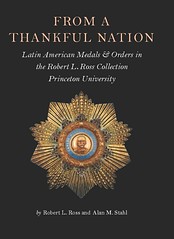 The exhibition features hundreds of Latin American decorations, ranging from a plain silver medal awarded to an officer of the Buenos Aires armed forces that freed Montevideo from Spanish colonial rule in 1814, to Guatemala’s highest award given to foreign presidents, the Collar of the Order of the Quetzal with its Mayan motifs, to a gilt example of the Cuban Order of Che Guevara, awarded for assistance to Latin America’s many left-wing movements of national liberation. Unlike the United States, which has generally avoided the award and wearing of medals as a vestige of European royal practice, the Spanish-, Portuguese-, and French-speaking nations of the New World have embraced such displays as tangible expressions of appreciation for the efforts of their soldiers and citizens.
The exhibition features hundreds of Latin American decorations, ranging from a plain silver medal awarded to an officer of the Buenos Aires armed forces that freed Montevideo from Spanish colonial rule in 1814, to Guatemala’s highest award given to foreign presidents, the Collar of the Order of the Quetzal with its Mayan motifs, to a gilt example of the Cuban Order of Che Guevara, awarded for assistance to Latin America’s many left-wing movements of national liberation. Unlike the United States, which has generally avoided the award and wearing of medals as a vestige of European royal practice, the Spanish-, Portuguese-, and French-speaking nations of the New World have embraced such displays as tangible expressions of appreciation for the efforts of their soldiers and citizens.
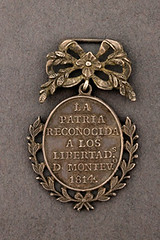 “From a Thankful Nation” traces the development of Latin American medals from their origins in the emblems of medieval crusading knights and the Spanish, Portuguese, and French royal and imperial orders through the revolutionary battles and the building of republics throughout the region. The use of medals as part of the governing strategies of dictatorial caudillos and adventuring “filibusters” is illustrated by such pieces as the pearl-adorned example of the Grand Cross badge of the Juan Pablo Duarte Order of the Dominican Republic that the dictator Rafael Trujillo, as grand master of the order, awarded to himself. While tracing the awards to common soldiers and laborers, the exhibition is most eye-catching with the display of no fewer than ten examples of Collars, the highest grade of an order (usually reserved for heads of state), as well as seventy Grand Cross sets, most replete with brightly colored silk sashes enameled gilt badges, and breast stars.
“From a Thankful Nation” traces the development of Latin American medals from their origins in the emblems of medieval crusading knights and the Spanish, Portuguese, and French royal and imperial orders through the revolutionary battles and the building of republics throughout the region. The use of medals as part of the governing strategies of dictatorial caudillos and adventuring “filibusters” is illustrated by such pieces as the pearl-adorned example of the Grand Cross badge of the Juan Pablo Duarte Order of the Dominican Republic that the dictator Rafael Trujillo, as grand master of the order, awarded to himself. While tracing the awards to common soldiers and laborers, the exhibition is most eye-catching with the display of no fewer than ten examples of Collars, the highest grade of an order (usually reserved for heads of state), as well as seventy Grand Cross sets, most replete with brightly colored silk sashes enameled gilt badges, and breast stars.
The exhibition is accompanied by a full-color catalogue written by Ross and Princeton’s Curator of Numismatics, Alan Stahl. In 736 pages of text and with 969 color photographs, it sets all of the official medals of each country in their historical context. The catalogue is for sale from the Library for $125; inquiries should be directed to loliveir@princeton.edu. The exhibition is also documented in a fully illustrated website: rbsc.princeton.edu/thankful-nation/.
Further information is available from Princeton’s Curator of Numismatics, Alan Stahl, astahl@princeton.edu , (609) 258-9127.
To read the earlier E-Sylum article, see: FROM A THANKFUL NATION: LATIN AMERICAN MEDALS (www.coinbooks.org/esylum_v17n06a06.html)
BOOK REVIEW: CHOPMARKED COINS: A HISTORY
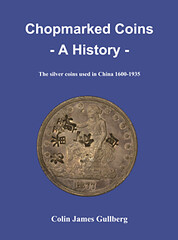 Gullberg’s new Chopmark Book
Gullberg’s new Chopmark Book
by Michael E. Marotta
Chopmarked Coins: A History; the silver coins used in China 1600-1935 by Colin James Gullberg (iAsure Group JEAN Publications, June 2014, 187 pages, 8-1/2 x 11, color ill., $40 + S&H).
According to the author, this is only the second English language book on chopmarks. The previous standard was the catalog of the Frank Marvin Rose Collection from 1987. Michael Chou and Peter Chou purchased both the Rose collection, which won Best of Show, at the ANA in 1991, and the rights to that publication. Michael Chou also provided the venture capital for this new book.
Chapter 1: “The History of Silver in China” is the core of this work, running 100 pages. The narrative is supported by a wealth of illustrations organized chronologically by the first year of issue. The 1732 Mexican Pillar Dollar is exemplified with a 1763 issue. A British East India Company rupee from 1879 stands for the series which began in 1862. Most of the coins come from Gullberg’s collection. However, many were reshot from the original Rose inventory. Other sources include the British Museum and Stacks Bowers.
The narrative is really a history of global trade and commerce because the world went to China for tea and silk and other commodities. Gullberg’s essay is supported by footnote references to standard works such as Sargeant and Velde’s Big Problem of Small Change, the works of Eduard Kann, and of course the Krause & Mishler Standard Catalog of World Coins. In addition, Gullberg drew on personal contacts in Taiwan who opened their archives for him. Among the illustrations are reproductions from a “shroff’s” (money changer’s) handbook from about 1890. The bibliography of sixty sources is at the back.
Gullberg explains the types of chopmarks–large, small, incuse, and relief—and attempts a taxonomy of time and place by series. For example: “To recap, very broadly small chops seemed to dominate from the cob period until around 1810. After 1820 large chops dominated until about 1910, when small chops returned. Pillar dollars are found with both, indicating that either large chops were also used in the 1730-70 period or these pillar dollar [sic] survived until after the 1820s, when silver prices were rising…” (page 118).
 Note that is not a catalog of chopmarks. Gullberg says that no tabulation ever was kept. Local merchants knew each other’s marks and the shoffs (money changers) likewise recognized them. But with one exception, no chopmark actually identified a person or business. That exception was the Tait & Co., tea traders of Britain whose two-character chopmark is their name, de-ji. If you have chopmarked coins, and you want to find a symbol or glyph, you will have to look at all the pictures. Some are easy and common, tien (heaven), for example.
Note that is not a catalog of chopmarks. Gullberg says that no tabulation ever was kept. Local merchants knew each other’s marks and the shoffs (money changers) likewise recognized them. But with one exception, no chopmark actually identified a person or business. That exception was the Tait & Co., tea traders of Britain whose two-character chopmark is their name, de-ji. If you have chopmarked coins, and you want to find a symbol or glyph, you will have to look at all the pictures. Some are easy and common, tien (heaven), for example.
Toward the end the book has three sections on counterfeits: genuine chops on fake coins; fake chops on fake coins; fake chops on genuine coins. Those follow a section on counterstamps, damage, and other things that are not chopmarks.
Gullberg claims that Hans F. Schulman, otherwise respected as a founder of both the PNG and IAPN, manufactured hundreds of fakes with a set of genuine chops he had acquired. He punched US Peace dollars, and other twentieth century world silver crowns. A lot of 50 was offered by The Money Company in their May 20, 1985 sale.
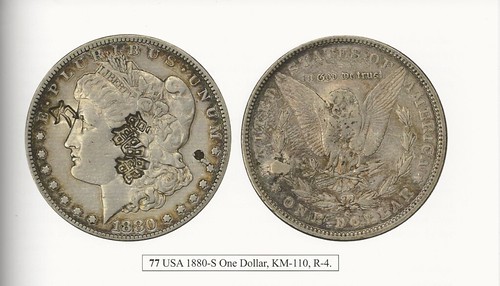
In the Introduction, Colin Gullberg explains that he had some exposure to coins and stamps as a child because his father, a Canadian attached to the US air defense, NORAD, often traveled. However, he only became aware of chopmarks in 2006. With a degree in English, he moved to Taiwan to teach. Taking his son to a coin store, he saw his first examples. He pursued the coins, and then founded the Chopmark Collectors Club, an ANA member society.
The book is for sale directly from the author. Send an email to Colin Gullberg chopmarknews@gmail.com to make arrangements. Payment is usually via Paypal. Gullberg lives in Taiwan but he has an associate stateside who helps with the Chopmark Collectors Club.
To read the earlier E-Sylum article, see: NEW BOOK: CHOPMARKED COINS - A HISTORY (www.coinbooks.org/esylum_v17n27a03.html)
BOOK REVIEWS: BNR PRESS WWII GUIDES
World War II Paper Money and Financial Instruments of Nazi Germany
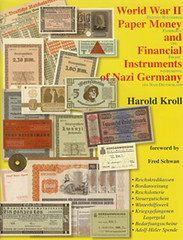 This is not an area I've ever collected. Having read the book, I don't think I would ever want to. But it's not the book's fault. It does a marvelous job of cataloging and illustrating these pieces with over 700 full color images filling 64 pages. It's just that the notes are so plain and businesslike. Functional, but boring. Few images, bland monotone colors, numbers and masses of text in tiny font. OK, so financial instruments are legal contracts, and I shouldn't be surprised that they're boring-looking. Nazis themselves are very interesting, as are the villains in any movie or novel. But not their paper money. I wouldn't fault anyone else for collecting them; it's a fascinating era of history, and the book spans a wide range of items from army issues, prisoner of war money, tax payment notes, ship notes and lottery tickets.
This is not an area I've ever collected. Having read the book, I don't think I would ever want to. But it's not the book's fault. It does a marvelous job of cataloging and illustrating these pieces with over 700 full color images filling 64 pages. It's just that the notes are so plain and businesslike. Functional, but boring. Few images, bland monotone colors, numbers and masses of text in tiny font. OK, so financial instruments are legal contracts, and I shouldn't be surprised that they're boring-looking. Nazis themselves are very interesting, as are the villains in any movie or novel. But not their paper money. I wouldn't fault anyone else for collecting them; it's a fascinating era of history, and the book spans a wide range of items from army issues, prisoner of war money, tax payment notes, ship notes and lottery tickets.
To read the earlier E-Sylum article, see: NEW BOOK: WWII PAPER MONEY AND FINANCIAL INSTRUMENTS OF NAZI GERMANY (www.coinbooks.org/esylum_v15n22a04.html)
American Red Cross in World War II Collector's Guide
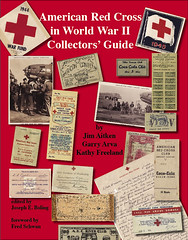 Now this topic is more to my liking. It starts with a great history of the Red Cross organization. While do-gooders themselves are the boring polar opposite of history's villains, their works and accomplishments are quite interesting. And to me, the paper items they generated are quite interesting as well.
Now this topic is more to my liking. It starts with a great history of the Red Cross organization. While do-gooders themselves are the boring polar opposite of history's villains, their works and accomplishments are quite interesting. And to me, the paper items they generated are quite interesting as well.
Membership cards, for example, were as plain as most Nazi items, but with lots of white space they seem lighter and friendlier. There is a great deal of variety - originality in contrast to the regimented German style. Short snorters and trench art have a friendly and whimsical vibe - originality over routine. And don't get me started on club money vs POW scrip. I doubt I'll ever form a collection of Red Cross items either, but thanks to this book I'll recognize them when I see them (and know who to sell them to, thanks to the buying ads sprinkled throughout).
To read the earlier E-Sylum article, see: NEW BOOK: AMERICAN RED CROSS WWII COLLECTOR'S GUIDE (www.coinbooks.org/esylum_v17n23a07.html)

DR. ARIE KINDLER 1920-2014
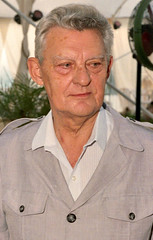 Dr. Arie Kindler, passed away last Wednesday, July 23rd, 2014, at the age of 94.
Dr. Arie Kindler, passed away last Wednesday, July 23rd, 2014, at the age of 94.
Dr. Kindler was born on February 17, 1920 in Berlin. From his early childhood he turned to archaeology. One of his early memories was the opening of the Pergamon museum in his hometown Berlin. He arrived in Israel with his family in 1933 after his father realized the impending danger. He joined the Hagana in 1938, serving for 10 years, followed by a service in the Israel Defense Forces from 1948 and reserve service until 1975.
During the early 1940s, he used to browse the merchandise of Arab peddlers selling antiquities and coins in the Jerusalem market and became an ardent collector. Though he was deeply interested in ancient history in general and Jewish history in particular, his real devotion was the study of coins. He concentrated on ancient numismatics, becoming a leading authority on Hasmonean coinage.
Dr. Kindler stood at the cradle of the circle for ancient coins, founded on May 10, 1945, which became the Israel Numismatic society in 1949. In 1962 he founded the Kadman Numismatic Pavilion of the Eretz Israel Museum, Tel-Aviv (formerly Haaretz Museum), serving as its director and curator for 35 years.
The museum started with a collection of 2000 coins donated by Leo Kadman (who also financed the building), 1000 from Kindler's own collection and another 500 coins from Dr. Walter Moses’ collection. These coins became the nucleus of one of the largest and most important collections in Israel. During his 35 years at the Kadman Numismatic Pavilion, Dr. Kindler added some 80,000 items to its collections through donations, legacies and acquisitions.
He curated numerous temporary numismatics exhibitions that attracted public interest, but his most important achievement was the opening of the permanent exhibition in 1988. His vision was that his new didactic exhibition should also tell the story of the development of means of payment, from its beginnings in the 7th century BCE to the modern era, emphasizing the history of Eretz Israel as reflected by its coins. Dr. Kindler believed that a curator must be also a researcher, and by the time that he completed his formal academic education, he was already a well-known scholar.
His extensive bibliography demonstrates his broad fields of interest and his important contributions to the study of Holy Land numismatics in general and Jewish numismatics in particular. Among his roles, he was the editor of 'Alon (the Hebrew Journal of the Israel Numismatic society published between 1966 and 1978), and member of the editorial board of the Israel Numismatic Journal.
Dr. Kindler published more than 200 scholarly papers in different areas of numismatics, from the Persian period Yehud coins, through Hasmonean, first and second Jewish revolts, city coins, Byzantine and Islamic periods to the coinage of the state of Israel. His publications also included seven monographs on various numismatic subjects. He wrote his Ph.D. dissertation on the the coinage of Bostra, which was subsequently published as a book in 1983.
Dr. Kindler lectured at the Israel Numismatic Society and taught at the Department of Classical Studies of the Tel Aviv University (1974–1988) and at Bar Ilan University (1981–1992). He trained numerous students in numismatics, some of whom became experts in the field, as well as collectors, amateurs and the general public. He was the numismatic expert for many archaeological expeditions and published the excavation coin reports. Arie Kindler is survived by his daughter, Yael, his two grandchildren, David and Chen, and three great-grandchildren
With his death the numismatic circles of Israel have lost one of their most active members, a great scholar and teacher. He will be missed and remembered with gratitude by his friends and colleagues.
Cecilia Meir
Curator
Kadman Numismatic Pavilion, Eretz Israel Museum, Tel Aviv
Photo: Leonid Pedrol-Kavytkovsky
To read the complete article, see: www.ins.org.il
QUERY: M. DAVID AND HULMEVILLE BANKNOTES
For research projects I am seeking information on Moritz David, also known as M. David and, in advertising, Mauritius David. He joined the ANA in 1899, donated a Washington medal of the Hall of Fame of Great Americans, by Anton Scharff, to the Boston Museum of Fine Arts in 1900, launched Antiques magazine in January 1900 (it also included information on coins) which lasted for two issues, was multi-lingual, and, important to my interests, sold an 1822 half eagle to Virgil Brand. He seems to be largely undiscovered by modern-day historians. His letterhead imprint is attached. I welcome any and all information anyone can provide concerning him.
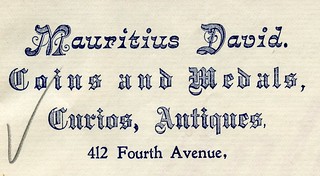
For another project I would like to obtain one or more signed and issued notes from the Farmers Bank of Bucks County (Pennsylvania) imprinted Hulmeville in the late 1810s and Bristol later. I would like notes from 1816 to 1821 only. Can someone help?
In other news, the Guide Book of Civil War Tokens, released in a print run of 5,000 copies by Whitman last autumn, sold out, the second printing is nearly so, and revisions and updated prices (by Steve Hayden) are now being assembled for a second edition, which will also include sutler tokens.
Best wishes,
Dave Bowers
Box 539
Wolfeboro Falls, NH 03896
qdbarchive@metrocast.net
2015 INTERNATIONAL NUMISMATIC CONGRESS
 It seems hard to believe that five years have passed
since the Glasgow Congress and that another is
now rapidly approaching. The XVth International
Numismatic Congress will be held in Taormina from
Monday 21 to Friday 25 September 2015. It is being
organised by the Department of Ancient and Medieval
Numismatics at the University of Messina.
It seems hard to believe that five years have passed
since the Glasgow Congress and that another is
now rapidly approaching. The XVth International
Numismatic Congress will be held in Taormina from
Monday 21 to Friday 25 September 2015. It is being
organised by the Department of Ancient and Medieval
Numismatics at the University of Messina.
Taormina is an ancient town situated on the northeast coast of Sicily in the shadow of Mount Etna. The old town sits on the hills above the modern town built around a typical Mediterranean bay. It is a beautiful and popular seaside resort with much of interest for the archaeologist, historian and numismatist. Sicily with its splendid numismatic tradition could not be a more apt place for a coin congress and Taormina produced its own issues in the third century BC.
The organising committee is chaired by Maria Caccamo Caltabiano, with Mariangela Puglisi acting as Secretary. Much progress was reported by Professor Caltabiano to the INC Committee at its recent annual meeting held in Glasgow.
The congress will take place in the old town with the main venue being the Palazzo dei Congressi, a modern conference centre situated just off the main street. It has a variety of lecture theatres and meeting rooms which can accommodate everything from the opening and closing sessions to the needs of a large and varied lecture programme. There are breakout areas for morning and afternoon coffee and discussion. Registration, information, book fair and poster show will be here too. The nearby medieval Palazzo Corvaja will also be used.
As always the core of the congress will be the scientific programme. This will consist of ten parallel sessions: General Numismatics; Communicating Numismatics; Ancient Greek coins; Roman coins; Other ancient coins; Medieval European and Byzantine; Modern Western European; Islamic, Asian and African; Oceanic and New World ; Medals. The Call for Papers is now open and there is a limit of 400, essentially on a first come – first served basis. The deadline for submitting a proposal and abstract is 30th November 2014. Anyone considering giving a talk should perhaps make their submission sooner rather than later. There is a limit of 50 for the poster session. Round Tables will include The New Landscape for Greek Numismatics and Religion and Money in the Middle Ages.
Registration is also open. The cost is 300 euros, reduced to 150 for members of the INC and students, and 75 for an accompanying person. However, after 1 June 2015 these rise to 450, 250, and 100 euros respectively. The registration fee covers entrance to the opening and closing ceremonies, all sessions, congress materials, tea and coffee breaks, an Inauguration Show, Welcome Reception and Cocktail Party.
There is a wide variety of accommodation which can be booked at the same time. For those staying in or visiting the new town there is a frequent, cheap and convenient funicular linking the old and new towns. There is a reasonable air service from Britain to Sicily, to Palermo and Catania airports. The latter is closer to Taormina with a direct airport bus link though there also a train service between Catania and Taormina.
A number of excursions have been organised for the Wednesday afternoon, 23 September, and all day on Friday, 25 September. The half day trips are to Ancient Naxos, Catania and the Alcantara Gorges (and Winery) while the full day ones go to Mount Etna (the volcano and its wines), Messina and Reggio Calabria, Syracuse and Noto, and Piazza Armerina, Morgantina and Aidone. There is a separate charge for these excursions which can be booked when registering. There is also a Congress Dinner in the San Domenico Palace Hotel on Thursday evening (24th September) which can also be booked and paid for with registration.
For more information on the Congress, see: XV International Numismatic Congress (www.xvcin.unime.it)
For more information on the Money & Medals Network, see: www.moneyandmedals.org.uk
NOTES FROM E-SYLUM READERS: AUGUST 24, 2014
Quiz Answer: Mystery Head Identified Last week I asked who could identify the person facing away from the camera in John Mutch's photo of me speaking at the 2014 NBS general Meeting on The Past, Present and Future of Online Numismatics.
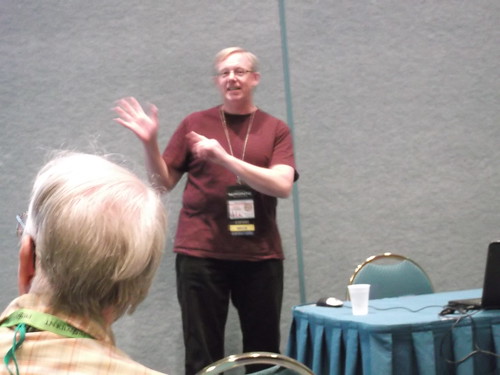
Pete Smith writes:
I enjoy an occasional quiz in The E-Sylum and answer when I can. Attempting to identify the back of the head included with your picture presented a bit of a challenge for me.
People who attended the meeting might try to remember who was sitting in that part of the room. The pattern of the shirt looked familiar. I also noticed that the person was wearing two identification badges.
I believe I can guarantee that I am the one person in the room who could not have seen the back of that head during the meeting. I will recuse myself from this quiz this week.
To read the earlier E-Sylum article, see: WAYNE'S NUMISMATIC DIARY: AUGUST 17, 2014 : The Past, Present and Future of Online Numismatics (www.coinbooks.org/esylum_v17n34a22.html)
The Medal Collectors of America Web Site Regarding last week's Featured Web Site, Anne E. Bentley, Curator of Art & Artifacts at the Massachusetts Historical Society writes:
Ben does a superb job on the website and it’s lovely to see it featured in the E-Sylum.

To read the earlier E-Sylum article, see: FEATURED WEB SITE: MEDAL COLLECTORS OF AMERICA (www.coinbooks.org/esylum_v17n34a30.html)
Granville Stokes Atlantic Cable Token Rarity Regarding the rarity of the Granville Stokes cable relic advertising token, Alan V. Weinberg agrees with Joe Levine that it is more common than the Rulau book estimates. He writes:
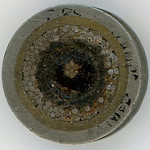 My estimate of known pieces well exceeds 20 specimens as compared to Rulau's estimate of 4 - 6. I personally have owned 5-6 different specimens over the years and seen others I did not own. Still, it is one of the most unusual American storecards but is obtainable with some patience for a few hundred dollars.
My estimate of known pieces well exceeds 20 specimens as compared to Rulau's estimate of 4 - 6. I personally have owned 5-6 different specimens over the years and seen others I did not own. Still, it is one of the most unusual American storecards but is obtainable with some patience for a few hundred dollars.
To read the earlier E-Sylum article, see: THE GRANVILLE STOKES ATLANTIC CABLE RELIC TOKEN (www.coinbooks.org/esylum_v17n34a17.html)
1792 Half Disme Research Regarding the 1792 Half disme research project being conducted by Len Augsburger, Joel Orosz and Pete Smith, Alan Weinberg writes:
 I had the distinct pleasure of briefly reviewing the manuscript, still a work in progress, at the ANA and was flabbergasted at the detail and accuracy of what I read. This will be some book when published. Fascinating stuff.
I had the distinct pleasure of briefly reviewing the manuscript, still a work in progress, at the ANA and was flabbergasted at the detail and accuracy of what I read. This will be some book when published. Fascinating stuff.
To read the earlier E-Sylum article, see: 792 HALF DISME LISTING ASSISTANCE SOUGHT (www.coinbooks.org/esylum_v17n34a06.html)
Coin Dipping Regarding the R.L. Miles collection, Alan Weinberg writes:
Shortly before the collection was auctioned by Stack's in the late 1960's it was on full display on the balcony at the NY Metropolitan Coin Show - then the 2nd most prominent coin show in the US - at the then Park Sheraton hotel , 7th Ave and 56th St, near Stack's. I viewed the exhibit and noted many of the copper coins - including a choice 1796 half cent had been dipped to a bright pink. I recall back then that natural silver and gold toning was not in favor and "bright" was in demand. How many nice original coins had their appearance altered by this market-favored dipping and cleaning? These coins are re-toned now over the years and considered "original".
To read the earlier E-Sylum article, see: THE R.L. MILES JR. COIN COLLECTION (www.coinbooks.org/esylum_v17n34a09.html)
More on Dealer Charlie Dochkus Dave Hirt writes:
I noticed one of people that information was asked about was dealer Charlie Dochkus. His name brought back memories to me. I met him once many years ago, probably around 1953-1954, at a country market near Boyertown, PA. There was a coin dealer there, and coins were also sold at auction. What brought Dochkus to a low brow place like that, I don't know, but with a group I walked with him to his car. He opened the trunk, and there was a vast array of coins. I was a high school student at that time, and could not afford the high grade material he had. That was the only time that I met him.
To read the earlier E-Sylum article, see: QUERY: COL. ROBERT C.H. BROCK AND ASSOCIATES (www.coinbooks.org/esylum_v17n32a18.html)
More on Hollywood Movie Money David Levy writes:
Regarding the article THE BUSINESS OF HOLLYWOOD MOVIE MONEY, I think the first picture (the two guys lying over the money pile) it is not from Rush Hour 2 but rather from Breaking Bad.
To read the earlier E-Sylum article, see: THE BUSINESS OF HOLLYWOOD MOVIE MONEY (www.coinbooks.org/esylum_v17n34a14.html)
THE BOOK BAZARRE
ANOTHER CHARLES PERCIER COIN CABINET
Scott Miller writes:
Regarding the V&A’s acquisition of a medal cabinet, there is a similar cabinet in the Metropolitan Museum of Art in New York. The Museum was given the cabinet by Collis P. Huntington in 1900. If I recall correctly, there are a number of medals that can be seen in the cabinet, though they appear to be later strikes.
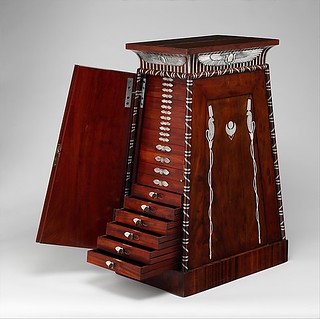 Coin cabinet
Coin cabinet
Designed by Charles Percier
(French, Paris 1764–1838 Paris)
Maker: Probably by François-Honoré-Georges Jacob-Desmalter (1770–1841)
Maker: Silver mounts by Martin-Guillaume Biennais (French, 1764–1843, active ca. 1796–1819)
Decorator: Decoration after drawings by baron Dominique Vivant Denon (French, Givry 1747–1825 Paris)
Date: ca. 1809–19
Culture: French, Paris
Medium: Mahogany, applied and inlaid silver
Dimensions: 35 1/2 x 19 3/4 x 14 3/4 in. (90.2 x 50.2 x 37.5 cm.)
Classification: Woodwork-Furniture
Credit Line: Bequest of Collis P. Huntington, 1900
Accession Number: 26.168.77
Dominique Vivant-Denon was director of the mint and of the Musée Napoleon (now the Musée du Louvre) as well as a collector and an arbiter of taste during the Napoleonic period. He accompanied the Egyptian campaign of 1798–99 as a draftsman and published his drawings as Voyage dans la basse et la haute Egypte (1802). The pylon at Ghoos, in Upper Egypt, served as the model for the top section of this medal cabinet, which was intended for Napoleon but remained in Denon's possession. The front and back panels are inlaid with a silver scarab flanked by uraei (sacred serpents) on lotus stalks. There are twenty-two drawers on each side of the cabinet, all inlaid with a silver bee. One wing is hinged to provide a pull.
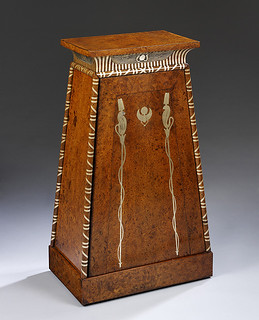

The V&A's Percier medal cabinet
To read the complete catalog entry, see: Coin cabinet Designed by Charles Percier (French, Paris 1764–1838 Paris) (www.metmuseum.org/collection/the-collection-online/search/195473?rpp=30&pg=1&ft=medal+cabinet&pos=7)
To read the earlier E-Sylum article, see: V&A ACQUIRES RARE MEDAL CABINET (www.coinbooks.org/esylum_v17n34a20.html)
QUERY: WHAT IS THIS MORGAN DOLLAR ITEM?
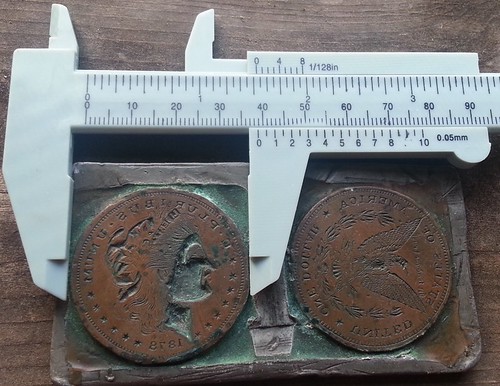
Heather writes:
I was born and raised in Shinnston, WV where my family first settled before the Revolutionary war. These were found in a box with papers dating from the late 1800's (my great great Aunt's belongings). I am not sure what they are. The engraved parts seem to be copper or brass embedded in tin or lead. I am just looking to identify what they might be.
It looks that each one is 36-37 mm. I would say it is the size of a silver dollar, but I haven't seen one of these before. It seems to have some type of wax on it, too. I didn't clean it as I wasn't sure if I should.
I would be very grateful if you published this in your newsletter, maybe someone will know what it is! My family has lived here since the 1650's, so it is hard to tell where it came from. They kept everything, I have deeds dating back to the 1700's. There is so much stuff, it is taking some time to get through it all. We keep finding these small treasures and want to know more about them.
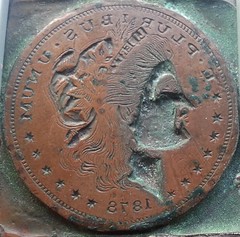

DC PROGRAM USES WOODEN TOKENS
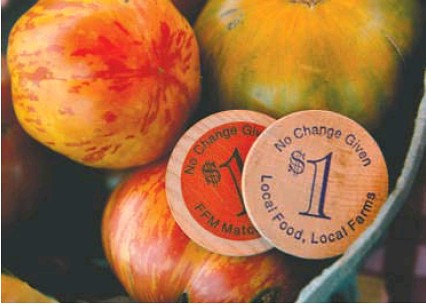
FreshFarm Markets tokens
Courtesy of a new program introduced by the District of Columbia’s Department of Health in partnership with farmers markets across the city, Haynesworth added a bag full of plums to her polka-dot grocery cart and turned her attention to the tomatoes.
Produce Plus provides low-income city residents with two $5 checks a week at certified District farmers markets and some community distribution sites to spend on fruit and vegetables this summer while the appropriated money lasts or until Sept. 30.
The D.C. Council allotted $135,000 for the purchase of food through the program, aiming to increase access to produce for those who may struggle to find money in their budgets for fresh fruit and vegetables. Recipients of Supplemental Security Income; Temporary Assistance for Needy Families; federal food assistance by way of SNAP, formerly known as food stamps; Medicaid; or WIC nutrition support for women, infants and children are eligible for Produce Plus.
To read the complete article, see:
DC program puts veggies on poor residents’ tables
(www.washingtonpost.com/local/dc-program-puts-veggies-on-poor-residents-tables/2014/08/17/ec4066f2-261d-11e4-8b10-7db129976abb_story.html)
For some shoppers, a big plus at farmers markets
To read the earlier E-Sylum article, see: ROCHESTER PUBLIC MARKET ADOPTS WOODEN TOKENS (www.coinbooks.org/esylum_v17n17a18.html)

COLLECTING WORLD COINS (BUT NOT NCLT)
In response to the comments of Kavan Ratnatunga and Dave Lange on the proliferation of non-circulating legal tender (NCLT) coins in the Krause 2015 Standard Catalog of World Coins 21st Century, Martin Purdy writes:
I'm pleased to see others complaining about the ballooning of "coin-like objects" (i.e. NCLT) in the latest edition of SCWC21. Mine arrived the other day and I commented in similar terms on a local message board. It is sheer madness that a book covering only 13 or so years should take up as much shelf space as the entire 20th century volume. I know the fault lies mainly with the makers rather than the cataloguers, but still, I looked through it the other night and nearly cried - if I'd known 40 years ago that that was the future of modern "coins" I probably would never have started. I prefer my medals to be designed and marketed as such, not passed off as "coins" with fictitious denominations on them.
George Cuhaj of Krause Publication writes:
We do have a product called Collecting World Coins which fits the bill. It is on a three year publication cycle In its 14th edition, the last publication date was Fall 2013.
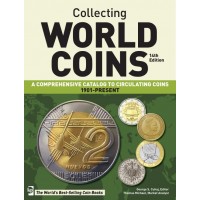 Collecting World Coins, 1901-Present, 14th Ed.
Collecting World Coins, 1901-Present, 14th Ed.
14th Edition
By George S. Cuhaj & Thomas Michael
Format: Paperback
You'll Love This If:
- You collect world coins
- You want detailed description of the coin, such as dates and mintages, metal, weight & current market value
This Collecting World Coins catalog is designed to offer a focused approach to world coin collecting, catering to the needs of the collector interested only in coinage minted for circulation in the past 100+ years. Circulating coins are used in everyday commerce and readily available to all, often turning up in pocket change at the end of the day. The catalog tells a comprehensive and complete story of the history of the modern world through the changes in government, monetary reforms and wars as recorded in circulating coins.
In This Collecting World Coins, 1901-Present Catalog You’ll Learn:
- Up-to-date and complete Euro Coin images and values.
- 30,0000 images for easy coin identification.
- Current market values in up to 5 grades
SKU U3686
Additional Feature 30,000 Black & White Illustrations Paperback
Author/Speaker/Editor George S. Cuhaj & Thomas Michael
File/Trim Size 8.25 x 10.88
Format Paperback
ISBN 13 9781440236181
Number Of Pages 1104
For more information, or to order, see: Collecting World Coins, 1901-Present, 14th Ed. 14th Edition (www.shopnumismaster.com/collecting-world-coins-1901-present-u3686)
 The Directory of Circulating Coins
The Directory of Circulating Coins
See How The World's Coins Are Changing
Worldwide, the coins being issued today are undergoing a transformation, combining unique technological innovations and new security features with novel designs, details and materials.
Published by Currency News™, the Directory of Circulating Coins is the only guide to every circulating coin in the world - making it an invaluable reference and research tool.
Every Coin, Every Country: One Indispensable Guide
The new directory provides detailed information on all the circulating coins in the world - including up-to-date information, specification and images in one concise and easy-to-use volume.
This makes it an indispensable guide for anyone involved in the design, production, quality control, validation or use of coins.
- 200 pages
- Covers every coin from the Afghani and the Ariary through to the Yuan and the Zloty
- Details of every denomination of each country’s circulating coins
- Includes images of the obverse and reverse of each coin
- Features dates for Year First Minted and Last Known Year of Minting
- Information on composition, diameter, weight, edge details, and description of motifs, security features and special notes.
For more information, or to order, see: The Directory of Circulating Coins (currency-news.com/the-directory-of-circulating-coins-2)
To read the earlier E-Sylum articles, see:
THE GROWTH OF NON-CIRCULATING LEGAL TENDER COINAGE
(www.coinbooks.org/esylum_v17n33a16.html)
NOTES FROM E-SYLUM READERS: AUGUST 17, 2014 : More on Non-Circulating Legal Tender Coinage
(www.coinbooks.org/esylum_v17n34a08.html)
NEW BOOK: COLLECTING WORLD COINS, 1901-PRESENT, 14TH EDITION
(www.coinbooks.org/esylum_v16n15a05.html)
NEW BOOK: THE DIRECTORY OF CIRCULATING COINS
(www.coinbooks.org/esylum_v17n25a03.html)
GOTHIC ART "COIN" INCORPORATES AGATE INSERT
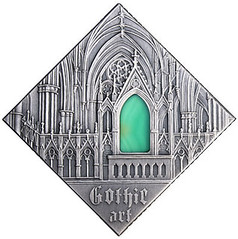
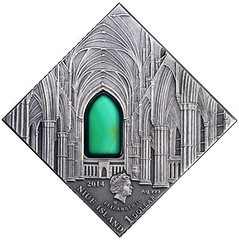
The Government & Treasury of Niue have launched a new coin which is part of their on-going series entitled “Art that changed the world.” This is a unique series presenting remarkable works of architecture of consecutive periods in art with the latest coin focusing on the Gothic style of architecture.
Gothic style originated approximately in 1120. In the early stages of its existence Gothic art developed in France. Later, around 1175, it continued to flourish in England. Gothic buildings are characterized by great lightness, numerous windows, usually stained-glass ones, soaring towers and lavishly ornamented portals. Other characteristic features of Gothic architecture include the use of pointed arches, cross-ribbed vaults and flying buttresses. The coin’s theme takes its design from the Cathedral Church of the Blessed Virgin Mary of Lincoln, located in Lincoln, England and seat of the Bishop of Lincoln in the Church of England. Building commenced in 1088 and continued in several phases throughout the medieval period. At one time, it was reputedly the tallest building in the world for 238 years from approximately 1311 to 1549.
The coin, which is designed by Robert Kotowicz is produced by the Mint of Poland on behalf of the Government of Niue and includes an insert of genuine agate incorporated into the design. The reverse depicts the chancel of the Cathedral in precise and intricate detail. The tabernacle is decorated with the insert of green agate. In the lower part of the coin is the inscription “GOTHIC ART” which is the name of the coin series.
The obverse design features the main nave of the Cathedral Church of the Blessed Virgin Mary of Lincoln. The front part of the nave is embellished with the green agate insert. In the lower part of the coin is a miniature profile portrait of HM Queen Elizabeth II and inscriptions “2014” the year of issue along with “NIUE ISLAND” and “ELIZABETH II 1 DOLLAR” The Mint of Poland’s mintmark is seen just to the lower left of the Queen’s profile
To read the complete article, see: Niue “Art That Changed the World” Series Features Gothic Art (news.coinupdate.com/niue-art-that-changed-the-world-series-features-gothic-art-4434/)
HOLABIRD SEPTEMBER 2014 WESTERN AMERICANA SALE
September 13-15, 2014
Auction Highlights
The sale features some of the rarest and most desirable of Western Americana, and Americana in general. Several major collections combine to offer some of the best material offered at public sale in decades. Among the collections from which we have drawn for this auction are the Bill Burger Collection, Ken Prag Collection, two impressive Colorado Collections and more, including the families of artists, mine owners and others. Many of the items are coming to auction for the first time.
Topical Directories
Various Railroad Directories (Poor’s etc); Mining Equipment directories, various, 1879-1922; Steamboat Directory 1856; Newspaper directories 1870’s; Express Directory 1860; Shippers Guide 1870; Jewelry dealers 1884; Masonic directories
Rare Books
Exploration guides for the California gold rush; Exploration guides for Pikes Peak (Colorado) gold rush; Exploration guides for Idaho mines (1860’s); Numismatic: Eckfeldt (1850 and 1851 editions); Arizona historical suite, including Mowry, etc; History of Idaho Territory 1884; Banditti of the Plains 1894 (cattleman’s war); Yellowstone 1868; Cliff Dwellers of Mesa Verde 1893; Illustrations of Colusa Co., Cal 1880; Olive Oatman bio and original CDV;
Numismatics
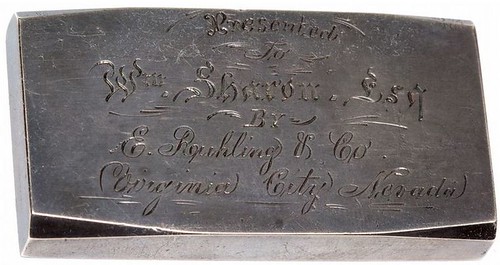
Ingots
This is one of the best rare ingot sections for public auction ever assembled. It includes several Western Assayer ingots, the very best of the collectible ingots: Theall (1869); Ruhling (1869, presentation to William Sharon); Riotte, Mathey, Kustel (1880); Presentation ingots: Ruhling to Sharon (1869); Mine Ingots: Gould & Curry (1904); Cerro Gordo, Vic Bernard (c1868-1875); Union Mine, Cerro Gordo (c1868-75); Austin or Eureka (c1890); Gould-Tylor, Salvage Mine (Downieville, c1900, gold ingot). Post-1900 American ingots (more than 200!): Mine ingots: Homestake; Idaho mines; Cripple Creek; Leadville; Tombstone; others. Refinery ingots: many different. Commemorative ingots dating from the 1940’s. US Mint ingots: San Francisco, others.
Coins
The rare Texas 1839 Fantasy Piece (Ford)
Books
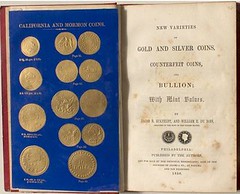 The two California gold rush Eckfeldt volumes (1850 with original packet of California gold dust) and the 1851 volume with more illustrations of the Private issues.
The two California gold rush Eckfeldt volumes (1850 with original packet of California gold dust) and the 1851 volume with more illustrations of the Private issues.
Scrip and Checks
Clark Gruber checks; Colorado Scrip
Tokens
 (about 500!): California, including the rare Bodie Delury & Garcia: Nevada – many ghost towns and saloons, including two different from Palisade American Saloon Tokens from all over!
(about 500!): California, including the rare Bodie Delury & Garcia: Nevada – many ghost towns and saloons, including two different from Palisade American Saloon Tokens from all over!

Australian Gold Rush token
For more information, see: http://holabirdamericana.com/
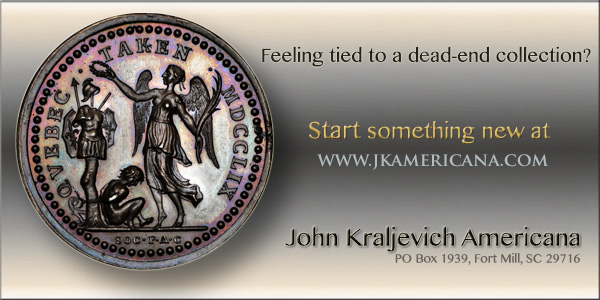
GALE PUBLISHING FOUNDER FREDERICK RUFFNER DIES
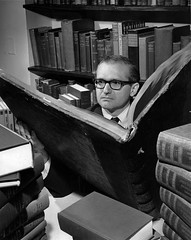 Frederick G. Ruffner Jr., an inveterate collector of information who founded the Gale Research Co., an empire of directories, dictionaries, biographies and bibliographies that stocked reference libraries for decades, satisfying urgent curiosity and waiting for questions not yet asked, died Aug. 12 at a hospital in Detroit. He was 88.
Frederick G. Ruffner Jr., an inveterate collector of information who founded the Gale Research Co., an empire of directories, dictionaries, biographies and bibliographies that stocked reference libraries for decades, satisfying urgent curiosity and waiting for questions not yet asked, died Aug. 12 at a hospital in Detroit. He was 88.
He founded his company — Gale was an old family name — in Detroit in 1954. Mr. Ruffner was working at the time as a marketing manager for a firm that sold firefighting equipment and set out in search of a directory of trade associations that might expand his contacts.
When he found in circulation no volume sufficiently current for his needs, he decided to compile one himself.
Working alongside his wife, with headquarters on a card table in their home, Mr. Ruffner typed and edited the first edition of the volume now known as the Encyclopedia of Associations. While perhaps lacking the glamour of many a bombshell bestseller, it proved highly useful for professionals across industries. To Mr. Ruffner, it demonstrated the commercial value — as well as the utility — of carefully curated information.
He followed his first directory with hundreds of other titles, including the Code Names Dictionary, the Acronyms, Initialisms and Abbreviations Dictionary, and Picturesque Expressions, a collection of sayings. Gale Research became particularly known for its series of literary reference guides, including the Dictionary of Literary Biography, Contemporary Literary Criticism and the venerable Contemporary Authors.
The company grew to employ hundreds at the central location in Detroit and at satellite offices, said Peter Ruffner. In 1985, Mr. Ruffner sold his company for $66 million to International Thomson.
He subscribed to 300 magazines and maintained a warehouse that housed his personal reference library. “In case I ever want to look something up,” he said.
To read the complete article, see: Frederick G. Ruffner Jr., titan of reference books, dies at 88 (www.washingtonpost.com/entertainment/books/frederick-g-ruffner-jr-titan-of-reference-books-dies-at-88/2014/08/23/8de8830a-2a4b-11e4-86ca-6f03cbd15c1a_story.html)
WHO GETS YOUR E-BOOKS WHEN YOU DIE?
Tom Fort writes:
This article will be of interest to those readers who think that ebooks are the way of the future.
The fate of your online life after death is a sensitive topic, and one both the law and technology companies have struggled with how to handle. Last week, Delaware Gov. Jack Markell took one step toward a possible solution, signing into law first-of-its-kind legislation that will grant Delawarean families the right to the digital assets of loved ones who are incapacitated or deceased, the way they would be given access to physical documents. But our Twitter, Facebook, or Gmail accounts are not our only online assets.
The Delaware law raises the complexities of how to deal with the accounts that house our e-book collections, music and video libraries, or even game purchases, and whether they can be transferred to friends and family after death. The bill broadly states that digital assets include not only emails and social media content, but also “data … audio, video, images, sounds … computer source codes, computer programs, software, software licenses.” However, the law says that these digital assets are controllable by the deceased’s trustees only to the extent allowed by the original service’s end user license agreement, or EULA.
If you’ve read your Kindle or iTunes EULA, you’d know just how little control over your e-books or music you have. Every time you hit “buy” at the Kindle store, you are not purchasing an e-book; you are licensing it for your personal use only. Even if you reread your e-copy of The Hobbit twice a year for 10 years, you are no closer to owning it, and without Amazon’s permission, no closer to being able to hand it down to your children. Professor Gerry Beyer at Texas Tech University says that the Delaware statute does not override this feature of Amazon’s, or most, EULAs, which are protected by other forms of federal law. “The bill is not designed to change an asset you could not transfer into one you can,” he told me.
Mark J. Cutrona, deputy director of the Delaware General Assembly Division of Research who helped draft the legislation, said in an email that although the bill could allow a trustee to access and control such digital assets, the complex web of laws and contracts needs further clarification. “This strays into a grey area relating to the legal differences between the treatment of physical and digital assets, which is a subject matter that may require further definition from the federal government and the courts in order to be fully addressed,” he wrote....
For now, estate planners are coming up with creative solutions. Beyer told me that some planners suggest setting up a trust and using it to purchase digital assets. By naming themselves and their children as trust beneficiaries, these forward-thinkers can pass down e-books or music, ostensibly without breaking any ban on third-party transfers. Of course, this idea is very new, he added, and has not been legally tested. And tech companies could easily shut down the scheme by stipulating that an account holder must be “human” rather than a trust.
To read the complete article, see:
Who Owns Your iTunes Library After Death?
(www.slate.com/blogs/future_tense/2014/08/22/
digital_assets_and_death_who_owns_music_
video_e_books_after_you_die.html)
QUIZ ANSWER: FIELDS MEDAL DESIGNER R. TAIT MCKENZIE
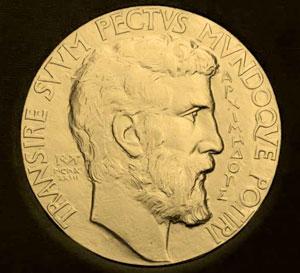 Last week I asked who could name the Canadian sculptor of the Fields medal, the most valued prize in mathematics.
Scott Miller writes:
Last week I asked who could name the Canadian sculptor of the Fields medal, the most valued prize in mathematics.
Scott Miller writes:
It appears to be the work of R. Tait McKenzie, with his monogram to the left of the bust.
The Fields medal was designed by a Canadian sculptor R. Tait McKenzie. Its obverse carries the image of Archimedes and a quote attributed to him, which reads "Transire suum pectus mundoque potiri" in latin, whose English translation is "Rise above oneself andgrasp the world."
To read the complete article, see: Fields Medal: Nobel Prize for Young Mathematicians (nopr.niscair.res.in/bitstream/123456789/12877/1/SR%2048(10)%2038-39.pdf)
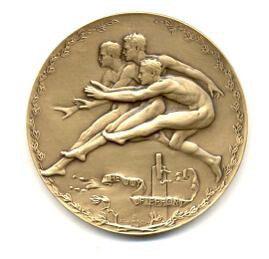 "THE JOY OF EFFORT", 1914. Kozar #35. 76.6mm. Silver. R. Tait
McKenzie, Sc. (MACO). Uniface. Edge with a very faint MACO Danbury edgemark. Uncirculated. A dynamic view of three runners in full stride as they pass over a hurdle. A banner below is inscribed: THE JOY OF EFFORT.
"THE JOY OF EFFORT", 1914. Kozar #35. 76.6mm. Silver. R. Tait
McKenzie, Sc. (MACO). Uniface. Edge with a very faint MACO Danbury edgemark. Uncirculated. A dynamic view of three runners in full stride as they pass over a hurdle. A banner below is inscribed: THE JOY OF EFFORT.
Kozar comments, "This medallion is recognized by those who know McKenzie's work as the most beautiful of all he produced." In its original form of 46", it was exhibited at the 1912 Olympic Games in Stockholm and was offered by the American section of the International Olympics Committee to Sweden as a permanent memorial to the fifth Olympiad. After it was accepted, the original plaster was cast into Bronze and set into the wall beside the stadium entrance.
In 1914 McKenzie was honored by the King of Sweden when he was presented with a Silver medal in recognition of his work in athletic sculpture. In that same year, the medallion was altered slightly in both the scrolling and the hurdle position. This newer version was signed "R. Tait McKenzie 1914" and it is that version that is offered here. $85.00
To read the earlier E-Sylum article, see: STANFORD PROFESSOR AWARDED FIELDS MEDAL (www.coinbooks.org/esylum_v17n34a16.html)
PHILADELPHIA MINT HITS NEW COIN PRODUCTION RECORD
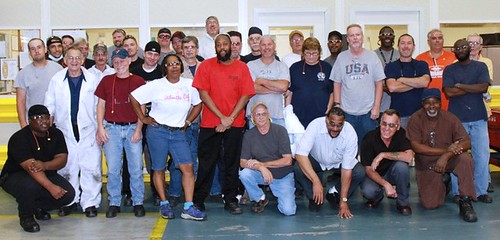
Philadelphia’s Coining division staff
The Coining Division at the United States Mint in Philadelphia hit a record on July 24, 2014—42.44 million coins delivered in one day, easily surpassing the old record of 38.28 million set in October 2013.
While production of 30 million coins per day is not uncommon at the Philadelphia Mint, producing over 40 million in one day is a an amazing accomplishment. Every employee, department, machine, part, die, tool, and blank has to be perfect and perform flawlessly.
“Beating the old record by over four million coins with the same number of presses was a tremendous achievement,” said Joe Falls, Coining Division Manager. “There were many key factors—first and foremost was the dedication and hard work of our employees. But we also had outstanding die life, great blanks from BAU and near-perfect press availability.”
THE BOOK BAZARRE
THE ASSAYER'S BLOWPIPE
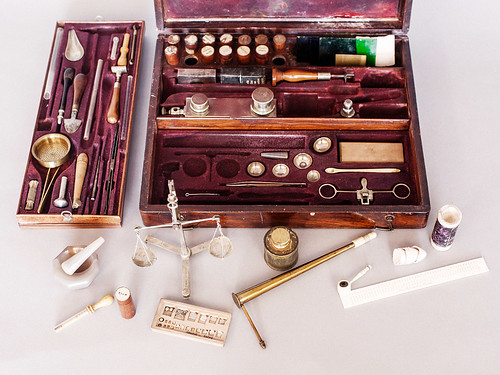
Pretend for a minute that it’s 1875 and you’re a mining engineer whose job it is to figure out how much gold is in them thar hills. Get it wrong, and your company is going to waste a lot of time and money hunting for gold that’s not there—or worse yet, miss out on the mother lode.
Not to worry, though, you’ve totally got this. You grab your trusty blowpipe kit, much like the gorgeous set above, and get to work.
Blowpipes have been used for centuries to identify which elements are present in a mineral sample, says William Jensen, an emeritus chemistry professor at the University of Cincinnati. In fact, Jensen says, blowpipes were used in the original discoveries of about a dozen elements, from nickel (in 1751) to indium (in 1863). This kit, produced around 1870, could be used for that type of analysis, but it could also be used to figure out how much of a particular element was in a sample of ore.
Portable kits like this were first developed in the 1830s at the Freiberg Mining Academy in Germany, Jensen says. “These kits would allow someone to set up a table and do the assay right at the mine site instead of taking samples back to the lab.”
The secret to the blowpipe is the intense heat it created.
Here’s how it worked: First you’d chip off a small sample of ore and weigh it with the scale (visible just in front of the case). Then you’d combine the ore with some tiny lead pellets in a scorification dish (those are the little clay dishes inside the front part of the case), and heat the whole thing with the alcohol lamp (the silver object in the middle of the case with two round caps—one for the wick and one for adding fuel).
This is where the blowpipe comes in. It’s the long L-shaped brass object with the white ivory mouthpiece in front of the case. By exhaling steadily through the blowpipe (never inhale!), you add oxygen to the flame that can increase the temperature above 2,000 degrees Celsius (3,632 degrees Fahrenheit). “You’re huffing and puffing because you’ve got to keep that airflow constant,” Jensen said. There’s a trick to blowing through puffed out cheeks while simultaneously inhaling more air through your nose to keep the flow going, Jensen says.
At that point, some of the lead would oxidize and react with any silicates in the ore to produce a glass-like substance called slag, and the rest of the lead would form an alloy with any gold or silver in the sample. You’d end up with a tiny chunk of glass and a tiny bead of metal alloy.
To read the complete article, see: The Strange Blowpipe 19th Century Miners Used to Analyze Ore (www.wired.com/2014/08/crazy-blowpipe-apparatus/)
CLASSICAL NUMISMATIC GROUP AUCTION 97 HIGHLIGHTS
Classical Numismatic Group of Lancaster, Pennsylvania and London, England is proud to present Auction 97, an Internet and Mail Bid Sale closing electronically on Wednesday, September 17, 2014, from 9 AM ET (U.S.). CNG 97 features 1055 lots of ancient Greek, Celtic, Oriental Greek, Central Asian, Roman Provincial, Roman Republican, and Roman Imperial coinage. Additionally, there are featured selections of Byzantine, Early Medieval, Islamic, World, and British Coinage. The pre-sale estimate total for CNG 97 is $1,465,750.
The Greek section of the sale opens with a hoard of Eastern hacksilber, followed by selections from the Trinacria Collection of Sicilian Bronze, an offering of Judaean coinage from the Patrick H. C. Tan Collection, a pair of rare gold issues of Berenike II, and an exceptional array of early issues from Sidon.
Collectors of Roman coinage will be pleased to browse through further selections from the RBW Collection of Republican Coinage, a group of Judaea Capta issues, and an exceptional and diverse offering of Roman Imperial gold. Following that, the Byzantine and Islamic sections present additional pieces from the Iconodule Collection and new offerings from the Warden Family Collection of Pictorial Islamic Coinage.
Finally, the sale is rounded out with a pair of important British collections: the Collection of an Underwriter, featuring numerous important and rare East Anglian issues from the Anglo-Saxon period; and the D. F. Alder Collection, formed primarily through purchases from Seaby and Spink between the late 1950s and early 1980s.
Some of the individual highlights from CNG 97 are:
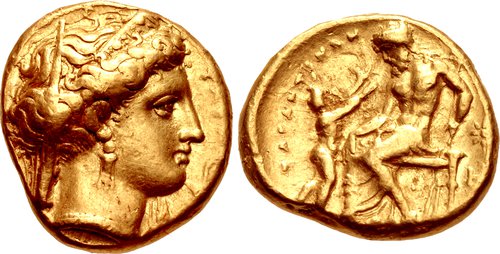
Lot 6–CALABRIA, Tarentum. Circa 320 BC. AV Stater (15mm, 8.51 g, 10h). Head of Persephone right, wearing a stephanos ornamented with palmettes, a slight veil, and triple-pendant earring; [E to left]; to right, T[APA] and small dolphin swimming downward / Poseidon, seated left on diphros, bow laying in his lap, cradling trident in his left arm and resting his right hand on his knee, looking down upon the child Taras, who stands right, raising both arms toward him; TAPANTINΩN to left; to right, star above |-; [K below diphros]. Fischer-Bossert G5 (V4’/R5); Vlasto 1 = Jameson 137; HN Italy 901; SNG France 1777–8; ACGC 685; Basel 89; Holloway, Art 8; Kraay & Hirmer 315 = Berlin 1 (all from the same dies). VF, minor die rust. Fine style. Very rare, only twelve examples noted by Fisher-Bossert, at least five of which are in museums (Berlin, Florence, London, Paris [2]); only one other than this in CoinArchives (Prospero). Estimated at $30,000
Ex Nomos 6 (8 May 2012), lot 3; Numismatica Ars Classica 48 (21 October 2008), lot 3.
To view the complete lot description, see: www.cngcoins.com/Coin.aspx?CoinID=265596
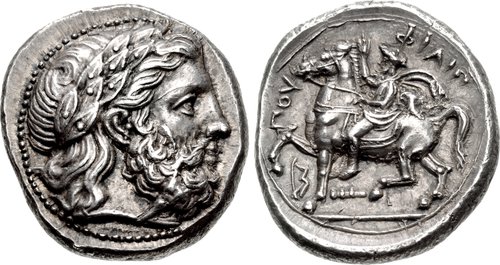
Lot 80–KINGS of MACEDON. Philip II. 359-336 BC. AR Tetradrachm (22mm, 14.48 g, 6h). Amphipolis mint. Struck circa 355-349/8 BC. Head of Zeus right, wearing laurel wreath / ΦIΛIΠΠOY, Philip, wearing kausia, chlamys, tunic, and boots, raising right hand and holding rein in left, on horseback left; bow below raised foreleg, horizontal club below belly. Le Rider 119a (D56/R101) = Lockett 1411 (this coin); SNG ANS 474 (same rev. die); SNG ANS 475 (same obv. die); SNG Berry 114. Superb EF, attractive old collection toning, insignificant die break on obverse. Struck in high relief from exceptionally detailed dies. Estimated at $10,000
Ex Mieza Collection (Nomos 7, 15 May 2013), lot 44; Nomos FPL (Winter-Spring 2009), no. 35; LHS 100 (23 April 2007), lot 216; Richard Cyril Lockett Collection (Greek Part II, Glendining, 12 February 1958), lot 1324.
To view the complete lot description, see: www.cngcoins.com/Coin.aspx?CoinID=265670
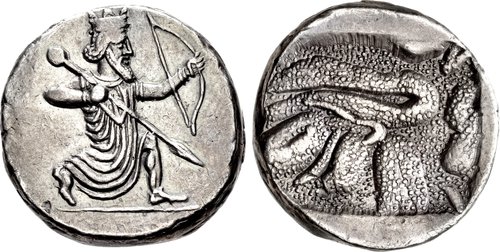
Lot 177–IONIA, Achaemenid Period. Uncertain satrap. Circa 350-333 BC. AR Tetradrachm (23mm, 15.06 g). Persian king, wearing kidaris and kandys, in kneeling-running stance right, holding spear in right hand, bow in left / Incuse rectangle, containing pattern possibly depicting relief map of the hinterland of Ephesos. Johnston, Earliest 5–17; Mildenberg, Münzwesen pp. 25–6 and pl. XII, 110; BMC Ionia p. 324, 3 and 6; Jameson 1787; Pozzi 3138. Near EF, dark toning, a little flat on head of king. Struck from fresh dies. Estimated at $10,000
Johnston has interpreted this remarkable reverse design as a relief map of the hinterland of Ephesos, which would make it the earliest Greek map and first physical relief map known. On the right (north) are the mountains Tmolos and Messogis between the river valleys of the Caÿster and Maeander, to the left of which are three mountain ridges (Madranbaba Dagi, Karincali Dagi, and Akaba Tepesi). Johnston follows Six in suggesting that the coins were probably struck under the Persian general Memnon at Ephesos, circa 336-334 BC, in order to pay his army after he had captured the city, but before his defeat by Alexander at the Battle of Granicus in 334. However, Johnston’s theory has been the subject of some doubt, most recently by Leo Mildenberg.
To view the complete lot description, see: www.cngcoins.com/Coin.aspx?CoinID=265767
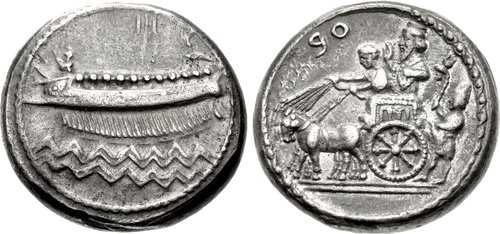
Lot 305–PHOENICIA, Sidon. Abdashtart (Straton) I. Circa 365-352 BC. AR Dishekel (27mm, 25.50 g, 12h). Dated RY 3 (363/2 BC). Phoenician galley left; ||| (date) above, waves below / Persian king and driver in chariot drawn by two horses left; AB in Phoenician above; behind, attendant standing left. E&E-S Group IV.2.1.c, 1246–7 var. (D7/R– [unlisted rev. die]); Betlyon 23 corr. (dates); Rouvier 1103; HGC 10, 242; DCA 849. EF, toned, minor die wear, light deposits on reverse. Exceptional detail for issue. Estimated at $15,000
From the Patrick H. C. Tan Collection. Ex Millennia Collection (Goldberg 46, 26 May 2008), lot 51.
To view the complete lot description, see: www.cngcoins.com/Coin.aspx?CoinID=265895
RESEARCHERS UPDATING BETTS ON AMERICAN COLONIAL MEDALS
We have spent the last six years working on an update and revision of Betts' American Colonial History Illustrated by Contemporary Medals, focusing on the early Betts medals issued prior to 1648. The most challenging part of our research has been seeking out medals missed by Betts and others.

The Metropolitan Museum of Art, Rogers Fund, 1960,
www.metmuseum.org
As a teaser of what is forthcoming, we decided to share one of our exciting discoveries with E-Sylum readers. The picture is of a large (175mm) and beautifully graphic gilt and lead medallion entitled “The Personification of America”. The medal is undated, but for the reasons that follow, we believe the medal is of German origin, and that based upon the medals elements matching the very earliest depictions of the New World, it can credibly be dated to the mid 1520’s or earlier – four decades before the first Betts medal which Betts dates to 1556!
More significant is that this medal was created within a generation of Columbus’ arrival in the New World, and reflects the earliest European impressions of the Americas. The medal’s design features the central figure of a Native Warrior Queen or Princess seen from behind, longbow in her right hand, staff in her left hand, pointing west. (Matching precisely the clothing style and long bows seen in a hand-colored woodcut from the 1505 Augsburg Edition of Amerigo Vespucci’s pamphlet Mundus Novus, depicting the cannibalism of the Tupinambas tribe of coastal Brazil; the very earliest known depiction of a Native American wearing a feathered headdress is seen on a Vatican fresco painted in 1494 by Pinturicchio).
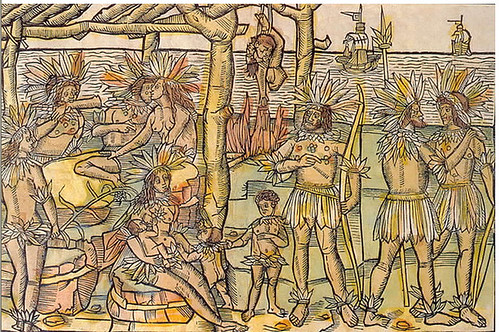
Cannibalism in the New World
Surrounding her are the riches of the New World, a treasure chest filled with silver or gold coins, a silver platter, a silver vase or pitcher, and the agricultural bounty of the Americas, maize (corn), tobacco plants, coconuts, and other plants which are possibly sweet potatoes, and coffee or cocoa beans.
Most interesting is that she is surrounded by the mysterious creatures of the South American jungle; a Macaw, two monkeys, a snake, a beastly creature seen on the left, and an armored rhinoceros on the right. These last two mysterious and curious creatures on the medal help date it.
The beastly creature on the left is actually an opossum, matching the image of an opossum seen on the cartouche of the 1513 Tabula Terre Nove (Admiral's Map) by Martin Waldseemüller.

Why a rhinoceros? We know today that a Rhinoceros is native to Africa and India, but within a few decades of Columbus’ landing, the Americas were seen as a mysterious place with amazing creatures, and the little known rhinoceros was also mysterious at that time, and could have easily been seen as coming from America. The Rhinoceros depicted on the medal - with armor plating and a second horn between its shoulders - is known as the Dürer Rhinoceros, from a well-known 1515 woodcut done by Albrcht Dürer, who also designed the 1521 Nuremburg medal of Charles V.

Durer's Rhino
While the Metropolitan Museum of Art in New York City dates this medal to the late 16th century (specifically 1580-1590) with this imagery seen on the medal contemporaneous to the late 1510’s we believe the medal is much earlier; as early as the late 1510’s and likely the mid 1520’s, allowing time for all of this imagery to come together in one piece.
The medal is one of four with an allegorical narrative depicting the “four parts of the world”- the four then-known continents (including Europe, Asia and Africa – and curiously enough the Africa medal does not include a Rhinoceros!). Sadly, this beautiful medal is exceedingly rare, and to our knowledge unique - we know of only one example of this medal, currently in the collection of the Met.
Another teaser - this early medal is still not the earliest medal we have discovered that should have been included in Betts.
We are currently working on rarity estimates for the medals, so would like to reach out to E-Sylum readers to seek their assistance in compiling a census of these early medals. If any of the Betts medals from Betts-1 (Charles V/PhillipII Novi Orbis) through Betts-38 (Dutch Victory at Pariba) are included in their collections, we ask that they contact us and provide us with the information about their holdings and any provenance so we can document the rarity of these medals for our Betts reference. Of course all information will be kept strictly confidential.
We also ask that readers let us know of any medals prior to 1648 pertaining to the New World which they believe should have been listed in Betts, and have not been catalogued in Betts, Van Loon, Pax in Nummis, and do not pertain to the treaties listed in Davenport, known as Davenport medals. We can be contacted at tonyjlopez@comcast.net or skyler.liechty@gmail.com.
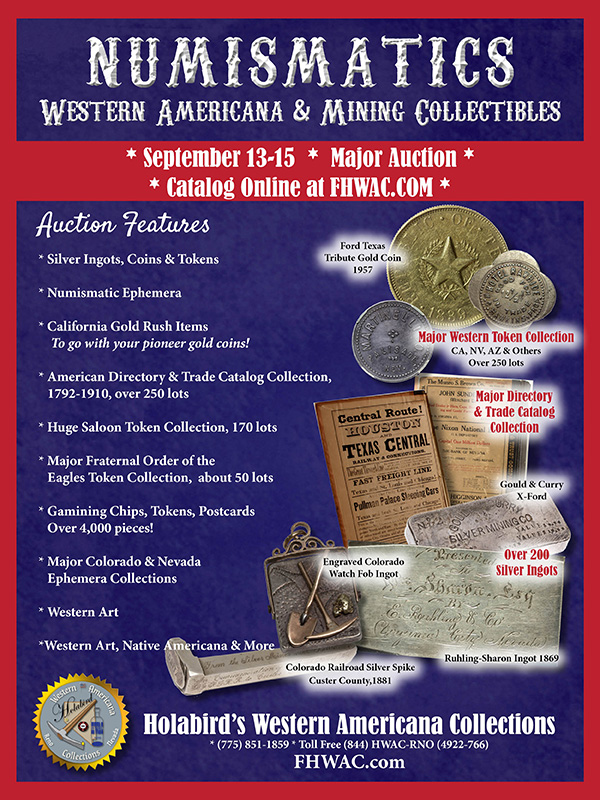
THE FOLEY COLLECTION OF EARLY ENGLISH MEDALS
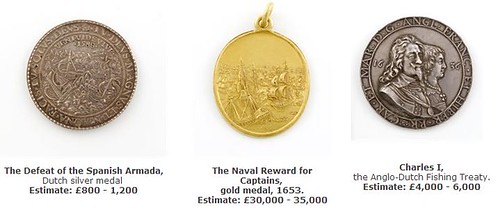
This extraordinarily comprehensive collection has been assembled over the past quarter century or so by Christopher Foley FSA., director for the last forty years of the old-established dealer in early English paintings, Lane Fine Art Limited. He has long specialised in British portraiture, and was initially attracted to these medals by the correlation between the iconography of grand court portraiture in oil paintings of the 16th and 17th centuries and their reproduction on a tiny scale in precious metals.
His first ever purchase in the field was the rare oval uniface portrait medal of Elizabeth I. He had recently bought and sold the famous George Gower “Sieve” portrait of the Queen, and acquired the medal as little more than a personal souvenir of that transaction. Encouraged by the egregious advice of Richard Falkiner FSA, he soon developed a taste for (not to mention a large collection of) early British medals. His personal preference was for the hammered and the hand-made, so in the early years the collection concentrated on the era from the medallic incunabula of the Tudors to the relative sophistication of the Commonwealth era. The later 17th century “milled” medals followed somewhat later.
Now approaching seventy, Foley retains the magpie-instincts of the collector, but has decided that the pace of new additions to the present collection has slowed to such a large extent that he would like to concentrate on a numismatic-related collection in an entirely different field, one which reflects both his early education as a Classicist and his life-long enthusiasm for archaeology. He will also expand his art and history library - already more than 6,000 volumes – to include manuscript material.
With nearly 600 lots of individual medals, such a dispersal is exceedingly rare and has hardly been equalled in size and scope for completeness in the last 100 years, this year marking the centenary of the J.E. Hodgkin sale. Exactly a decade before this was the J.G. Murdoch dispersal. The collection of T.M. Whitehead was a demonstration of what a dealer was able to come by in the years before 1898. The previous year saw the massive sale of the collection formed by Hyman Montague. Before this we go into the mists of time, via the Lord Pembroke sale in 1848, Samuel Tyssen (1802) and Dr. Mead (1755) but suffice it to say these were collections formed haphazardly by usually noble collectors, recipients perhaps, who acquired these treasures at the time they were made; perhaps even from the very hand of the monarch. All this places this current sale in a proper context.
To read the complete article, see: The Christopher Foley, F.S.A., Collection Of Early English Medals (www.woolleyandwallis.co.uk/departments/silver/sv161014.aspx)
HOWARD BERLIN VISITS THE NEW ORLEANS MINT
I was in Rosemont for the ANA and almost a few days later after returning home, my wife and I were on the plane for New Orleans. It’s nice being retired to travel a lot while trying to spend down our three childrens’ inheritances.
I was last in the Big Easy 40 years ago and we had planned many of the things most tourists do. However one stop I wanted to make was to see the museum of the United States Mint, which opened in 1981 with some closures for renovations. Also the admission price was right – free.
Even though I had not seen the Mint museum before, I have three pages in my Numismatourist book about the Mint with pictures provided by the museum. It is said a picture is supposedly worth a thousand words. However, nothing beats seeing things in person, especially when it relates to numismatics.
While on a hop-on-hop-off tour of the city, we got off at the French Market, which was block behind the Mint building on Esplanade Avenue. Also of interest, across the street from the mint is the Hotel de la Monnaie – The Mint Hotel. The Mint was built in 1835, with the first coins struck in 1838 and minting operations ceased in 1909.
It is the oldest surviving structure to have served as a U.S. Mint. It also holds the distinction of being the only mint to have produced both American and Confederate coinage. In 1975, the New Orleans Mint was designated a National Historic Landmark by the National Park Service.
When Louisiana seceded from the Union in 1861, the Mint struck coins for the Confederacy for less than one month, as it quickly ran out of bullion. On display on loan from the American Numismatic Society, is one of a few remaining silver 1861-O seated liberty half dollars.
As many collectors of U.S. coins may know, some varieties had very short runs at this Mint, some as little as two years. A few notable coins are the 1838-O silver three-cent silver – the only year a silver three-cent coin was struck by a branch mint and was also the smallest denomination silver coin. The 1838-O and 1839-O 50-cent silver capped bust and quarter eagle gold were the only two years the “O” mint mark appeared on the obverse, the first time that a mintmark appeared on the obverse. The 1854-O $3-gold was the only year the $3-gold piece was struck at the New Orleans Mint.
The Mint Museum has a number of interesting exhibits which include coins, machinery, documents, and relics relating to the daily operations of the coining department. A number of coins on display are on loan from the Federal Reserve Bank of Atlanta and a several collectors.
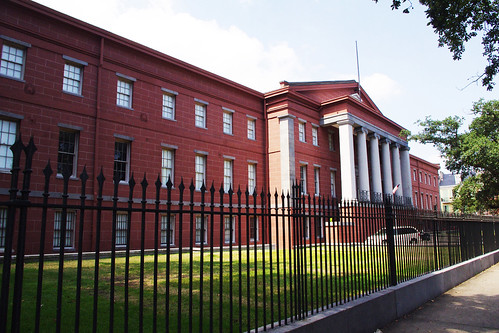
1. The front of the New Orleans Mint, whose free exhibition is on the building’s ground floor.
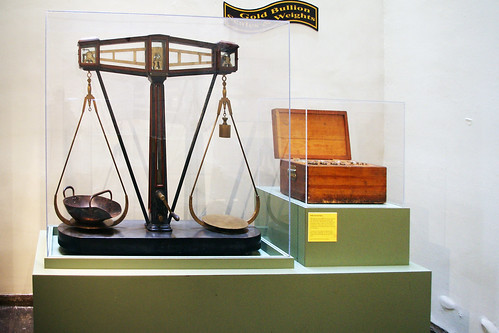
2. These large scales and weights were used to weigh gold bullion from one thousandth part of a grain to 750 ounces. After the mint closed these were shipped to the Atlanta Federal Reserve Bank, which opened in 1914.These are similar to those still used by the Federal Reserve Banks of New York and San Francisco.

3. This is probably a presentation ingot, weighing 8.85 ounces and .999 fine. Its dimensions, weight, and fineness are not the same as for standard coining ingots of 10 percent copper and shaped into 12-3/8” x 1-5/8” x ½” bricks.
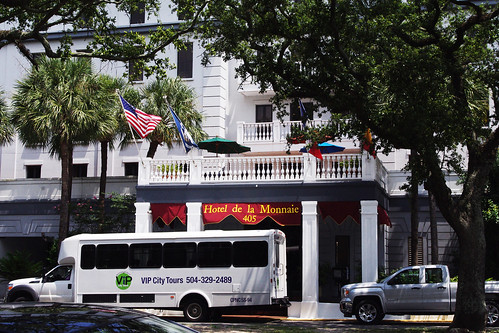
4. The appropriately named Hotel de la Monnaie (Mint Hotel) is located across the street from the Mint.
NORSE-AMERICAN COPPER DIE TRIAL DISCOVERED
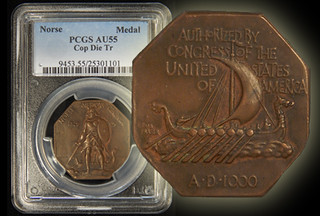 A new example of a very rare copper die trial of the Norse-American commemorative struck at the U.S. Mint in Philadelphia has recently been discovered by a Midwest coin shop. It’s only the second Norse die trial known in copper. An unconfirmed piece with an unknown metal composition is rumored to have surfaced a few years ago in the eastern U.S. and a uniface example is known, also in an unverified metal composition.
A new example of a very rare copper die trial of the Norse-American commemorative struck at the U.S. Mint in Philadelphia has recently been discovered by a Midwest coin shop. It’s only the second Norse die trial known in copper. An unconfirmed piece with an unknown metal composition is rumored to have surfaced a few years ago in the eastern U.S. and a uniface example is known, also in an unverified metal composition.
According to Brian Timmons of Harbor Coin in Winthrop Harbor, Illinois, a local customer brought the Norse commemorative into the shop along with a few other coins he wanted to sell. “An employee of the shop told the man we weren’t interested, but passed the piece to me anyway. I was familiar with the Norse commemorative, but up to that point I had never seen one in copper. At first I was skeptical, but after examining the piece I decided to buy it.”
The Norse-American commemorative is a long-time favorite among collectors of early U.S. commemorative coins. Technically a medal, because it doesn’t have a denomination, the Norse-American commemorative was issued in 1925, right along with a bevy of similar silver commemorative half dollars. While other proposed commemorative issues were bogged down in Congress, the Norse commemorative was authorized for striking without a denomination so it could be available in time for the Norse-American Centennial celebration in St. Paul, Minnesota held June 6 to 9, 1925 at the Minnesota State Fair Grounds.
To read the complete article, see: Important New Norse-American Copper Die Trial Recently Discovered (www.coinweek.com/commemoratives/important-new-norse-american-copper-die-trial-recently-discovered/)
THE BOOK BAZARRE
1909 VDB LINCOLN CENT STILL GATHERING DUST ON MARS
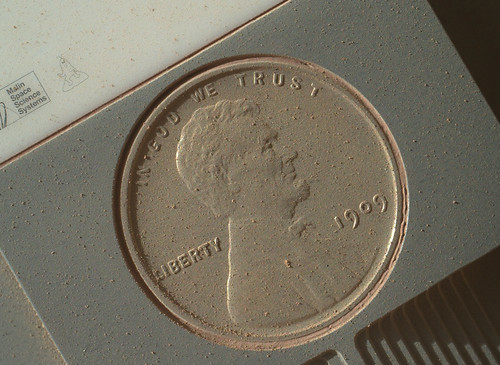
This image of a U.S. penny on a calibration target was taken by the Mars Hand Lens Imager (MAHLI) aboard NASA's Curiosity rover in Gale Crater on Mars. At 14 micrometers per pixel, this is the highest-resolution image that MAHLI can acquire.
This image was obtained as part of a test on the 411th Martian day, or sol, of the mission (Oct. 2, 2013), the first time the rover's robotic arm placed MAHLI close enough to a target to obtain the camera's highest-possible resolution. It shows that, during the penny's 14 months (so far) on Mars, it has accumulated Martian dust and clumps of dust, despite its vertical mounting position on the calibration target for MAHLI.
This United States penny from 1909 is part of a series of markings and objects meant to help calibrate the cameras that Curiosity is equipped with.
For more Before/After images of the rover, see:
Look at what two years on Mars did to the Curiosity Rover
(www.theverge.com/2014/8/20/6046609/its-hard-out-there-for-an-interplanetary-robot)
To read the earlier E-Sylum articles, see:
Roman Khudyakov had argued that catching a glimpse of Apollo’s naked loins on the 100-rouble note could be damaging to children and the notes should therefore be taken out of circulation.
But the deputy, an ultra-nationalist with the Liberal Democratic Party in Russia’s State Duma lower house of parliament, was put in his place by a letter from the Central Bank, Izvestiya reported on Friday.
The newspaper said a deputy chairman of the bank had written to the MP explaining that the offending illustration was not pornographic, as he had claimed, but in fact too small to be offensive.
The 100-rouble note features an image of the statue of Apollo riding his four-horsed chariot that sits atop the portico of the Bolshoi Theatre in central Moscow. In it, the god’s robe is pulled slightly above his waist to reveal a very faint and small depiction of his private parts.
To read the complete article, see:
Russia rejects appeal to ban 'pornographic' bank note
(www.telegraph.co.uk/news/worldnews/europe/russia/11051282/Russia-rejects-appeal-to-ban-pornographic-bank-note.html)
To read the earlier E-Sylum articles, see:
The brass coin, thought to be from the Qing Dynasty and minted between 1736 and 1795, was found on Elcho Island last month by a group of heritage enthusiasts called Past Masters.
Group spokesman Mike Owen said they were following the instructions of the NT Government.
"They [the NT Government] said if we found anything it had to go back," he said.
"That was in discussions we had last year," he said.
The heritage group, which includes a geomorphologist, an anthropologist and several archaeologists, was on Elcho Island, about 600km east of Darwin off the coast of Arnhem Land when they made the discovery.
They located the coin using a metal detector and said they photographed the item before throwing it into the sand dunes where it had been found.
News of its discovery sparked international interest, with some speculating on ancient links between China and northern Australia.
Others downplayed its importance, saying similar Chinese artefacts had been found around goldfields in the Northern Territory.
Others questioned whether the coin was really found at all.
"It reminds me of those guys that claimed to have shot a mythical wild Victorian panther, but decided to throw the carcass in the river after taking a photo," said one person posting on the site.
A spokeswoman for the NT Department of Lands, Planning and the Environment, which deals with heritage matters, said there was no rule or requirement that valuable items be returned to their original location.
To read the complete article, see:
Past Masters heritage group defends throwing old Chinese coin into sand dune
(www.abc.net.au/news/2014-08-22/heritage-group-defends-move-to-discard-old-chinese-coin/5689884)
The world’s largest hoard of Celtic coins was found in 2012 buried in a field in the Channel Island of Jersey. The hunk, which is 1.8m (6ft) long and 20cm deep, contains more than 70,000 coins glued together by verdigris and the clay they were buried in more than 2,000 years ago. Starting today, the solid mass will be dismantled, coin by coin, before each is identified, cleaned and catalogued.
The hoard was uncovered by Reg Mead and Richard Miles, two treasure hunters who had been searching the same field for more than 30 years after hearing of the discovery in the 1950s of another, far smaller hoard. They have joined conservators and Celtic coin experts in a laboratory in Jersey Museum, where members of the public are able to watch the delicate operation.
Thought to be worth as much as £10 million, the hoard, also known as Le Catillon II, was buried some time after Julius Caesar’s conquest of Gaul in 52BC. It would have consisted of a large part of the portable wealth of the Coriosolitae tribe who lived in Armorica, the area of modern-day Brittany around St Malo and Dinard.
The task of prising apart, cleaning and cataloguing the coins is expected to take at least three years. The plan is to remove between 60 and 70 a day, but no one knows exactly what lies within, as the lump is too thick to be x-rayed. Among the coins are tantalising glimpses of gold jewellery, hinting at more hidden treasures to come.
As Caesar wrote the only historic record of events in Gaul at that time, it may never be known what tribal conflicts prompted the flight to Jersey and the burial of the hoard.
What is clear is that people were hiding money on the island long before it became an offshore tax haven. Nearly a dozen smaller hoards from about the same period, totalling more than 100,000 coins, have been discovered.
David adds:
This is quite a hoard – I’ve been following the story for a couple of years.
To read the complete article, see:
Celtic hoard begins to give up its secrets after 2,000 years
(www.thetimes.co.uk/tto/news/uk/article4181529.ece?shareToken=6645635c736a808fb22df2d42fb36e4a)
Work to separate 70,000 Celtic coins and pieces of jewellery is taking place under the public gaze at Jersey Museum.
Researchers aim to remove and clean up to 500 coins a week for the next three years in a specially built glass-walled lab.
For the past two years the team, led by Jersey Heritage conservator Neil Mahrer, has been documenting the hoard, which is about 2,000 years old.
Mr Mahrer has been using a £40,000 laser scanner to create detailed three-dimensional imagery of the find.
The laser is so precise it can pick out intricate patterns minted thousands of years ago.
Once scanned, the coins will be separated, dipped in formic acid, washed and meticulously cleaned by hand under a microscope.
"It's very important to us to have the best possible record of the hoard the way it was found before we start taking it apart, because we only get one shot at it," said Mr Mahrer.
"We still can't see inside the thing. We tried to find out about getting it x-rayed but it's just too big and too thick so all we can do is look at the surface.
"What will come out over the next three years will be a surprise to us all."
To read the complete article, see:
Jersey hoard: Archaeologists unpick 70,000 coins
(www.bbc.com/news/world-europe-jersey-28900555)
Snakeskin coats. Silver goblets. A dozen guns.
Oh, and the gold.
All that was among the haul taken by federal investigators earlier this year from a Yelm couple since extradited to face fraud charges in Romania.
Having returned Radu and Diana Nemes to their native Romania – where they’re accused of duping the government out of $68 million in taxes – federal prosecutors in Seattle have asked that the spoils of the investigation be forfeited to the U.S. government. Among those items are hundreds of gold coins, a small portion of which are known to weigh more than 7 pounds and are valued at more than $140,000.
Investigators claim Radu and Diana Nemes, 38, used laundered money to pay for a $3 million log home while running shell businesses in Washington. Neither was charged in the United States, and both have since been extradited to Romania.
The couple left hundreds of gold and silver coins on their 53-acre Yelm property, which included an underground bunker. Ground-penetrating radar was brought in as agents looked for gold thought to have been buried there.
Among the items seized during the search was a single gold coin stamped with the words "Ramtha Gold Wisdom." Investigators contended the Nemes were involved in a fringe religious group based in Yelm whose founder contends she channels the spirit of "Ramtha."
To read the complete article, see:
Feds to bunker builders: We'll take your gold
(www.seattlepi.com/local/article/Feds-to-bunker-builders-We-ll-take-your-gold-5696438.php)
To read the complete article, see:
DIY Book Headboard
(www.designeverydayblog.com/diy-book-headboard/)
Numismatic Network Canada is the Internet portal for those interested in studying and collecting Canadian coins, tokens, paper money and related numismatic material. Originally created by the principal non-profit numismatic organizations in Canada to meet the needs of collectors, historians, researchers and other people interested in numismatics, wherever their location, this web site now both hosts web space and serves as a pointer to those Canadian numismatic organizations with their own sites on the Internet.
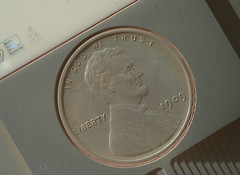
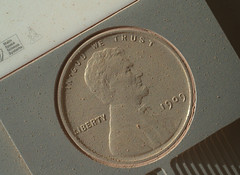
Before and After
IS A 1909 VDB LINCOLN CENT GOING TO MARS?
(www.coinbooks.org/esylum_v15n07a25.html)
THE CURIOSITY'S 1909 CENT PICKS UP LAYER OF MARTIAN DUST
(www.coinbooks.org/esylum_v15n39a28.html)
RUSSIA REFUSES TO TOUCH APOLLO'S GENITALS
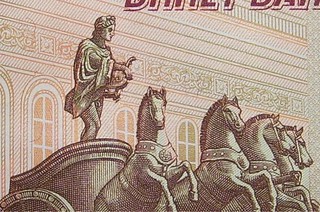 An MP’s campaign to protect vulnerable minors by removing a Greek god’s genitals from Russian banknotes has met with failure.
An MP’s campaign to protect vulnerable minors by removing a Greek god’s genitals from Russian banknotes has met with failure.
RUSSIAN LAWMAKER WANTS APOLLO'S GENITALS REMOVED
(www.coinbooks.org/esylum_v17n29a25.html)
NOTES FROM E-SYLUM READERS: JULY 20, 2014 : More on the 100 Ruble Note Picturing Apollo Statue
(www.coinbooks.org/esylum_v17n30a07.html)
AUSTRALIAN GROUP TOSSES FOUND CHINESE COIN BACK IN SAND
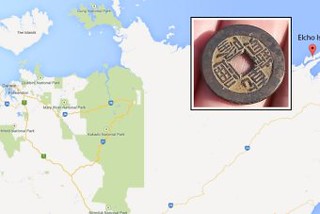 A Northern Territory heritage group is defending a decision to throw an old Chinese coin found on a remote island back into sand dunes, saying it did not have a choice.
A Northern Territory heritage group is defending a decision to throw an old Chinese coin found on a remote island back into sand dunes, saying it did not have a choice.
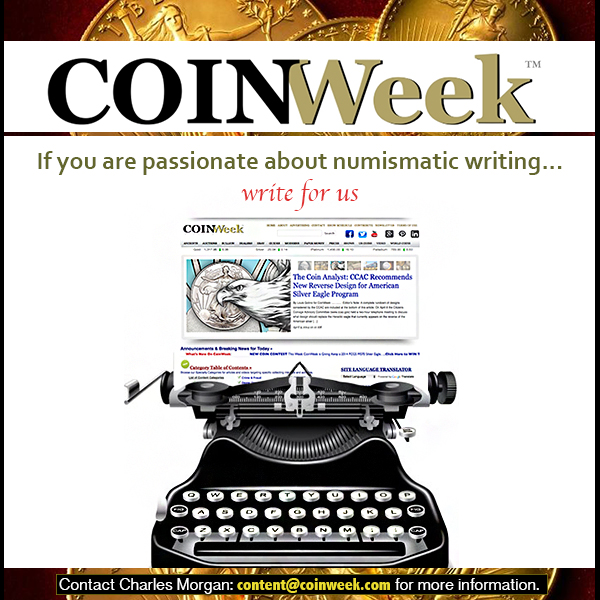
JERSEY GROUVILLE HOARD BEING DISMANTLED
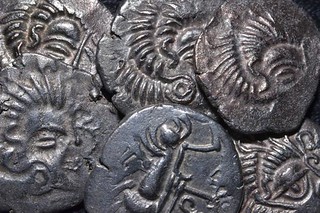 Green, kidney-shaped and weighing nearly a tonne, it is no thing of beauty. Yet the Grouville Hoard is a treasure trove and time capsule in one — and today it starts giving up its secrets.
Green, kidney-shaped and weighing nearly a tonne, it is no thing of beauty. Yet the Grouville Hoard is a treasure trove and time capsule in one — and today it starts giving up its secrets.

RAMTHA GOLD WISDOM COIN
THE DO-IT-YOURSELF BOOK HEADBOARD
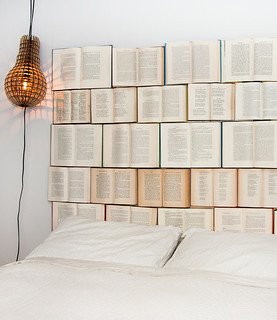

FEATURED WEB SITE: NUMISMATIC NETWORK CANADA
This week's Featured Web Site is Numismatic Network Canada.

www.nunet.ca
